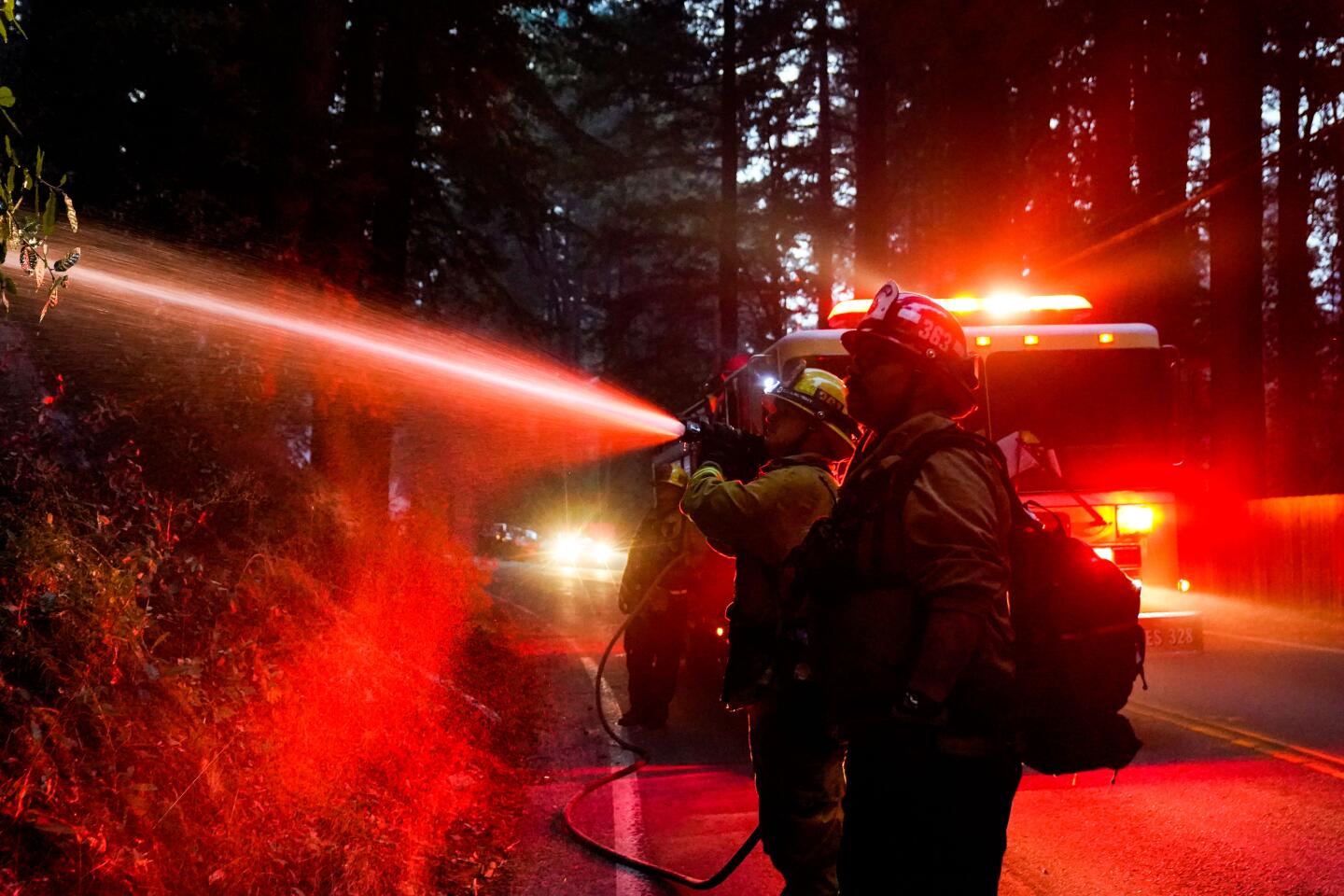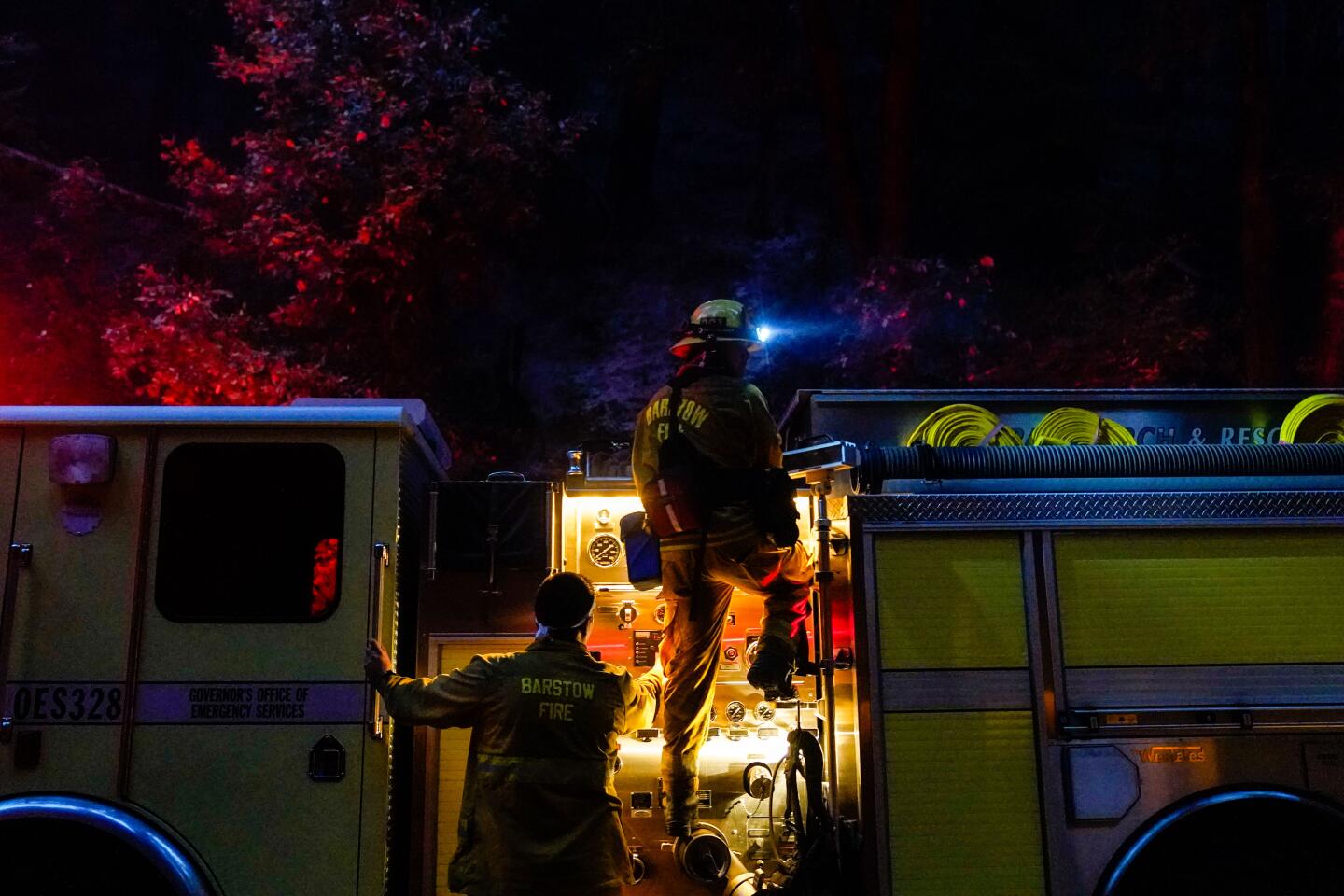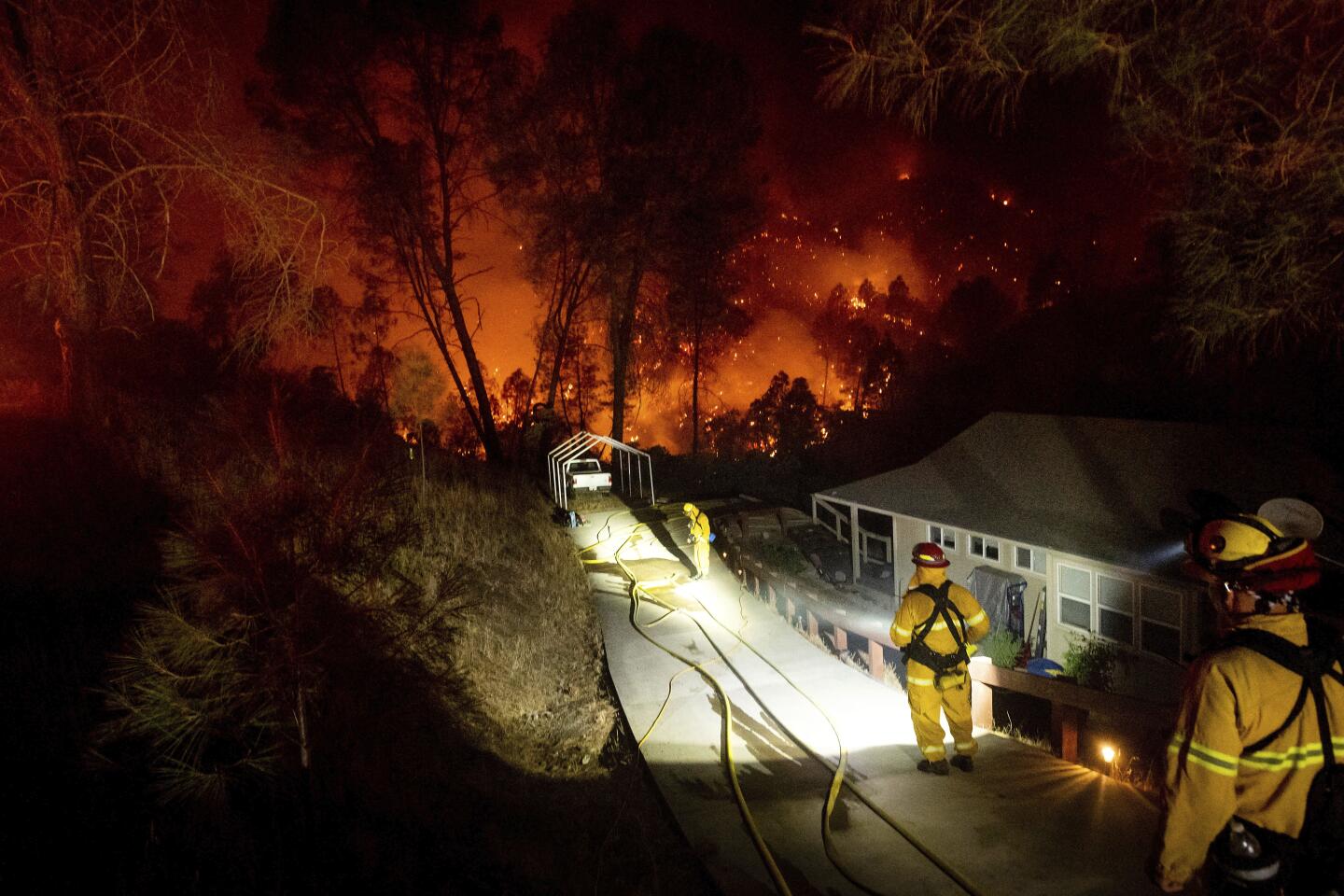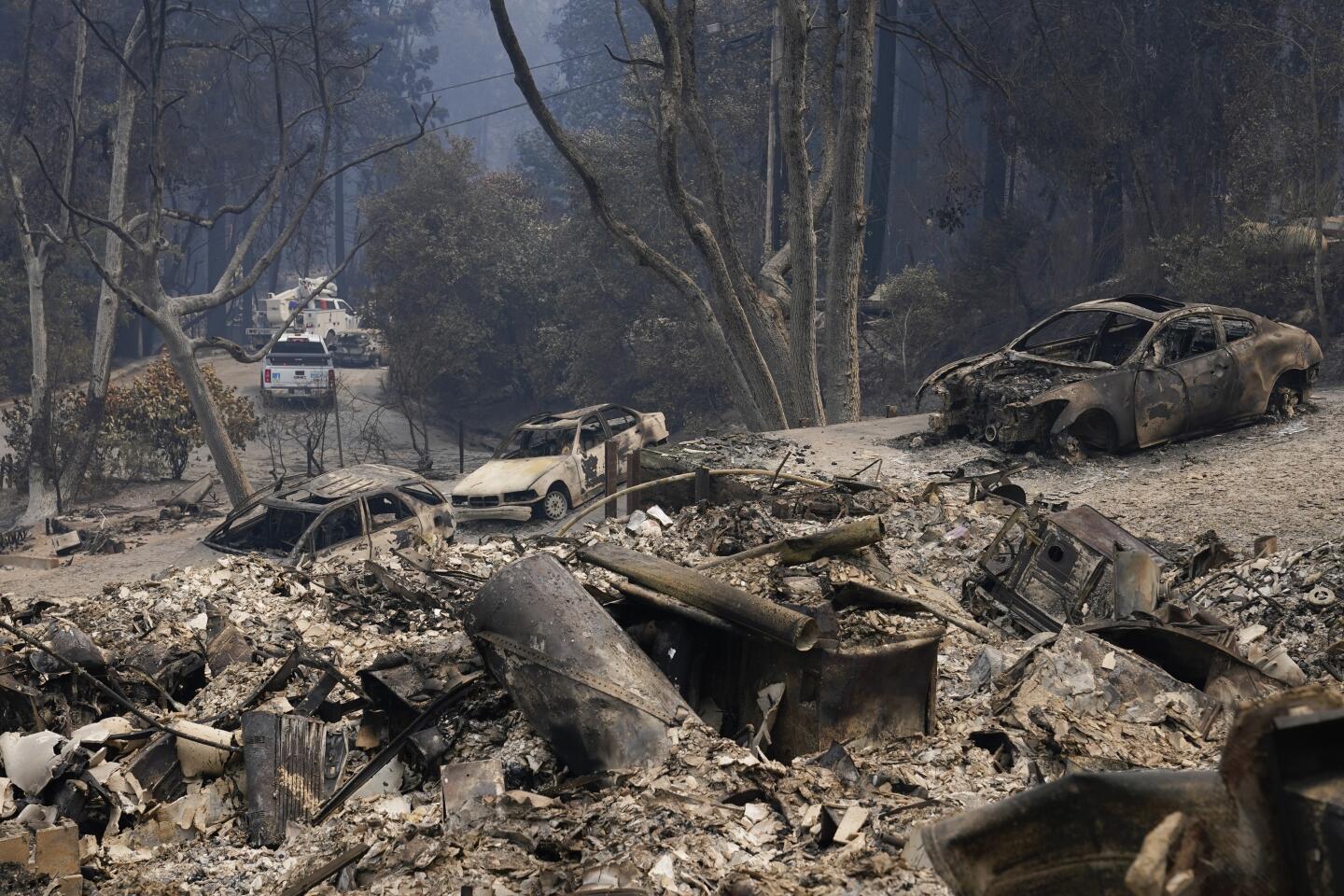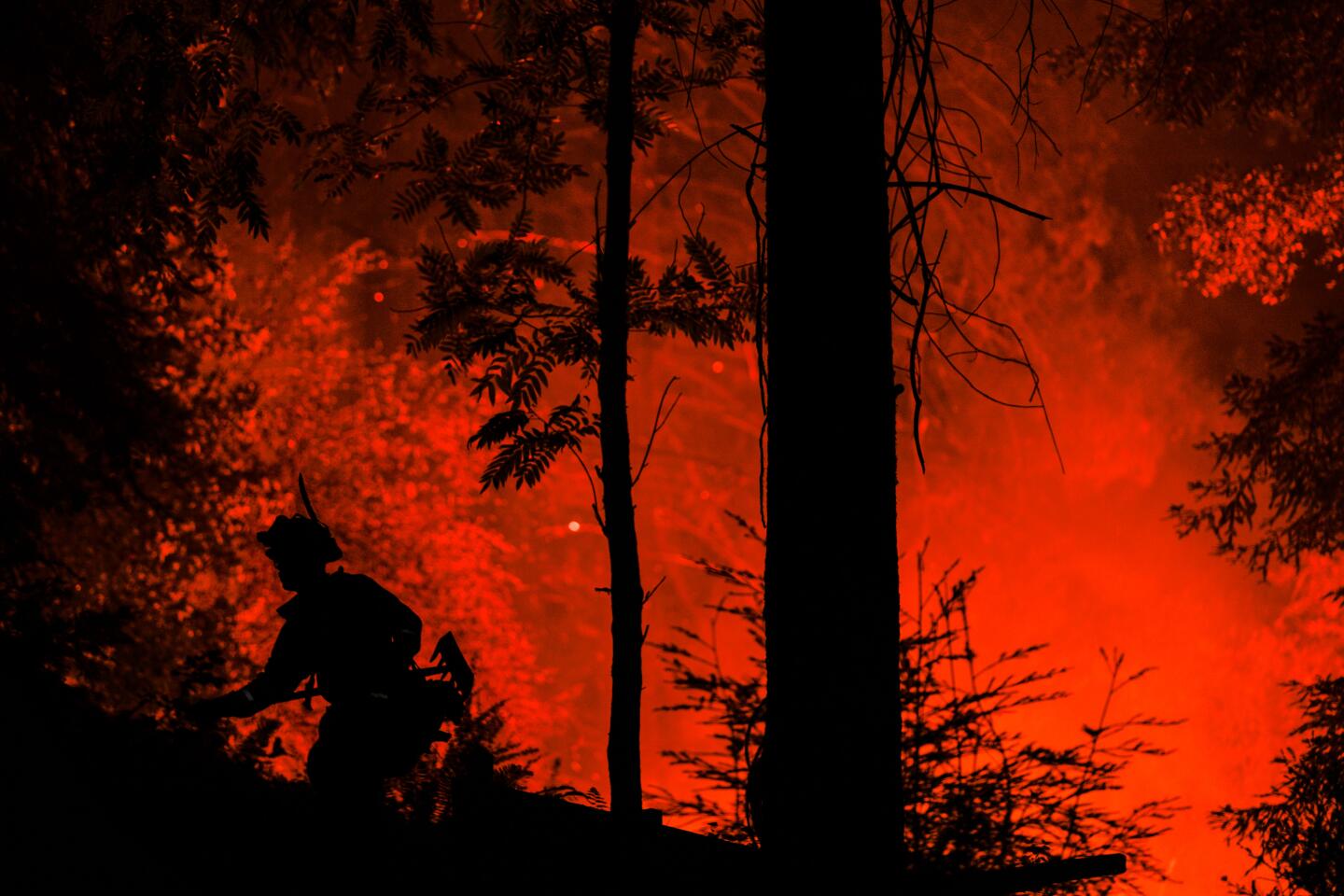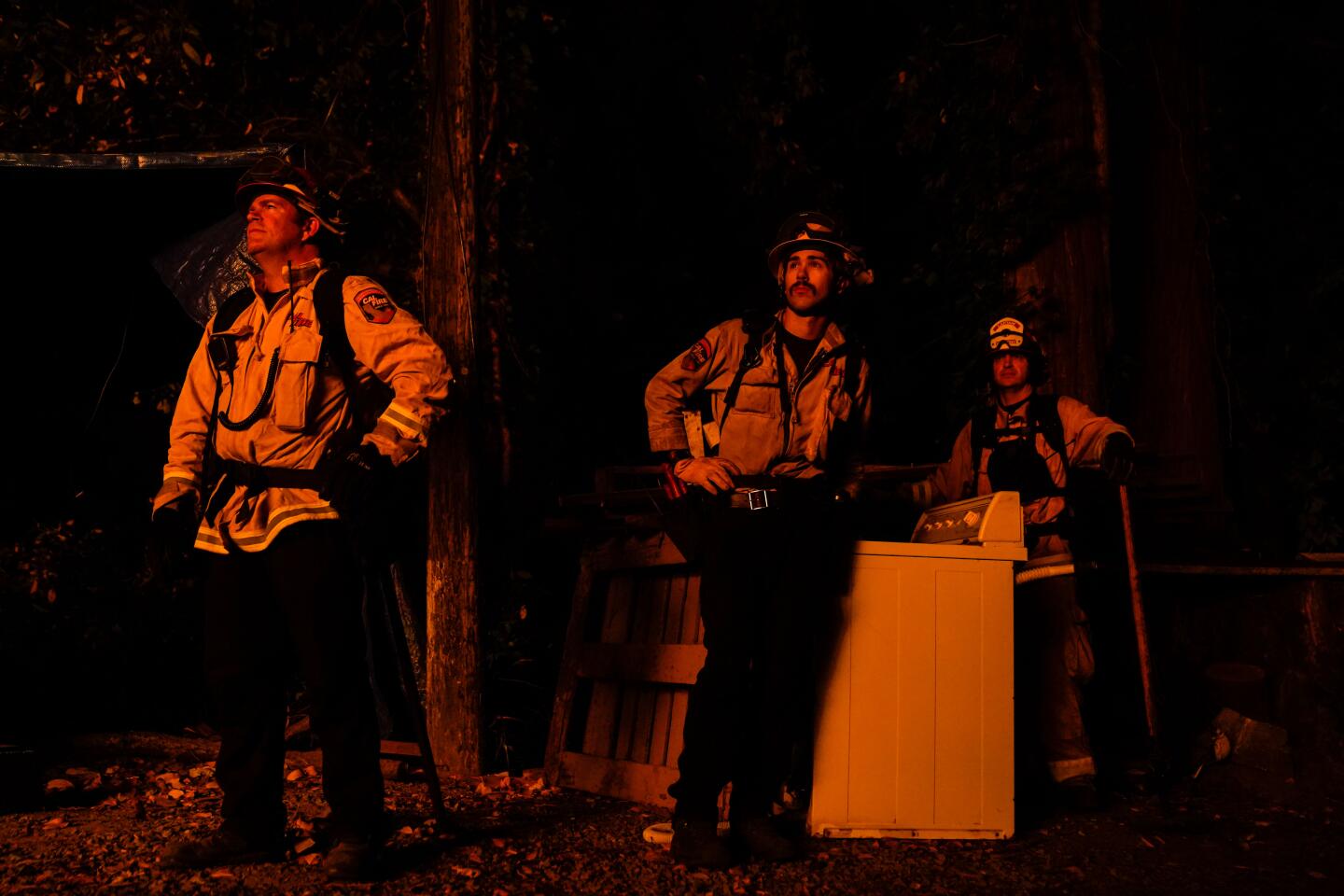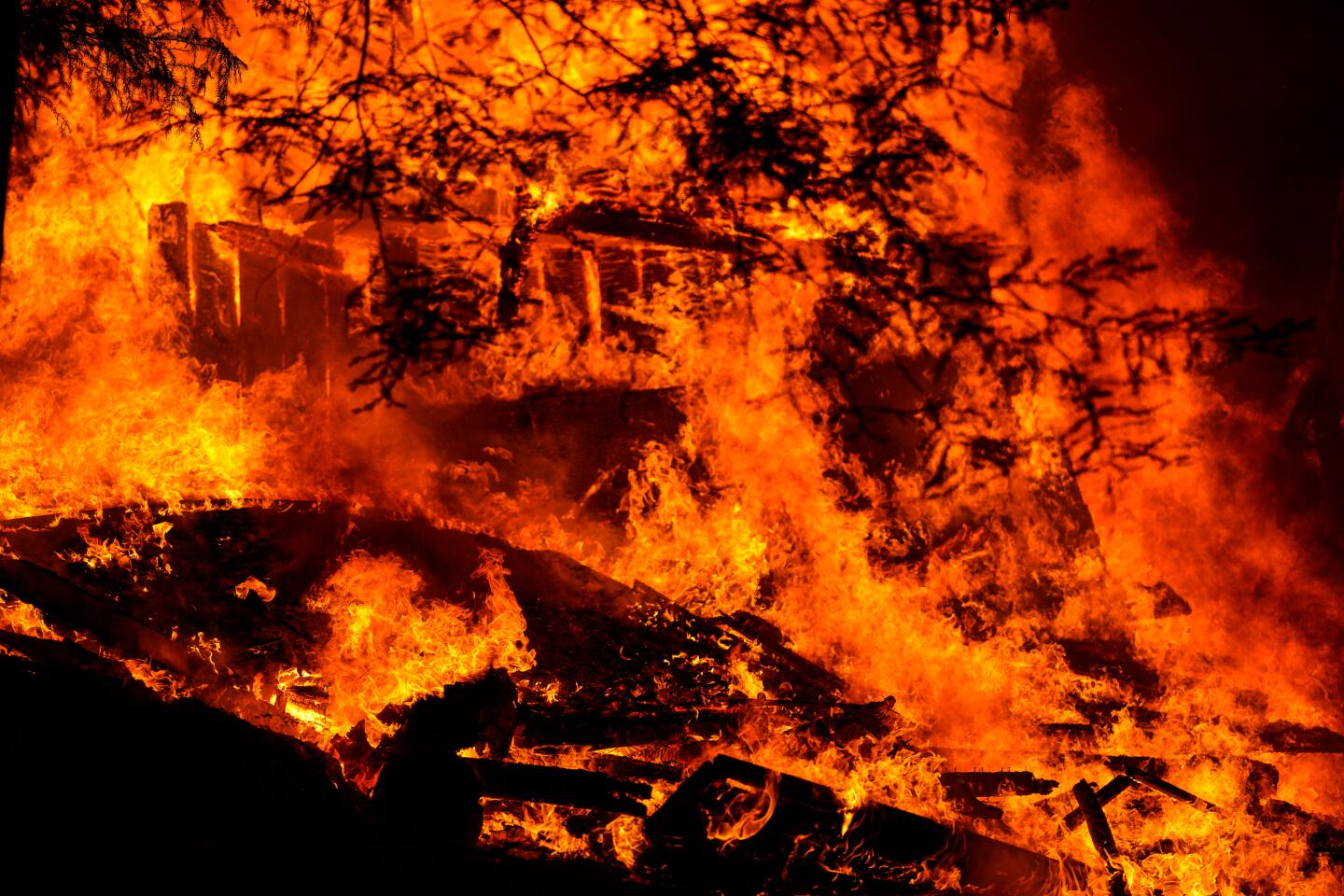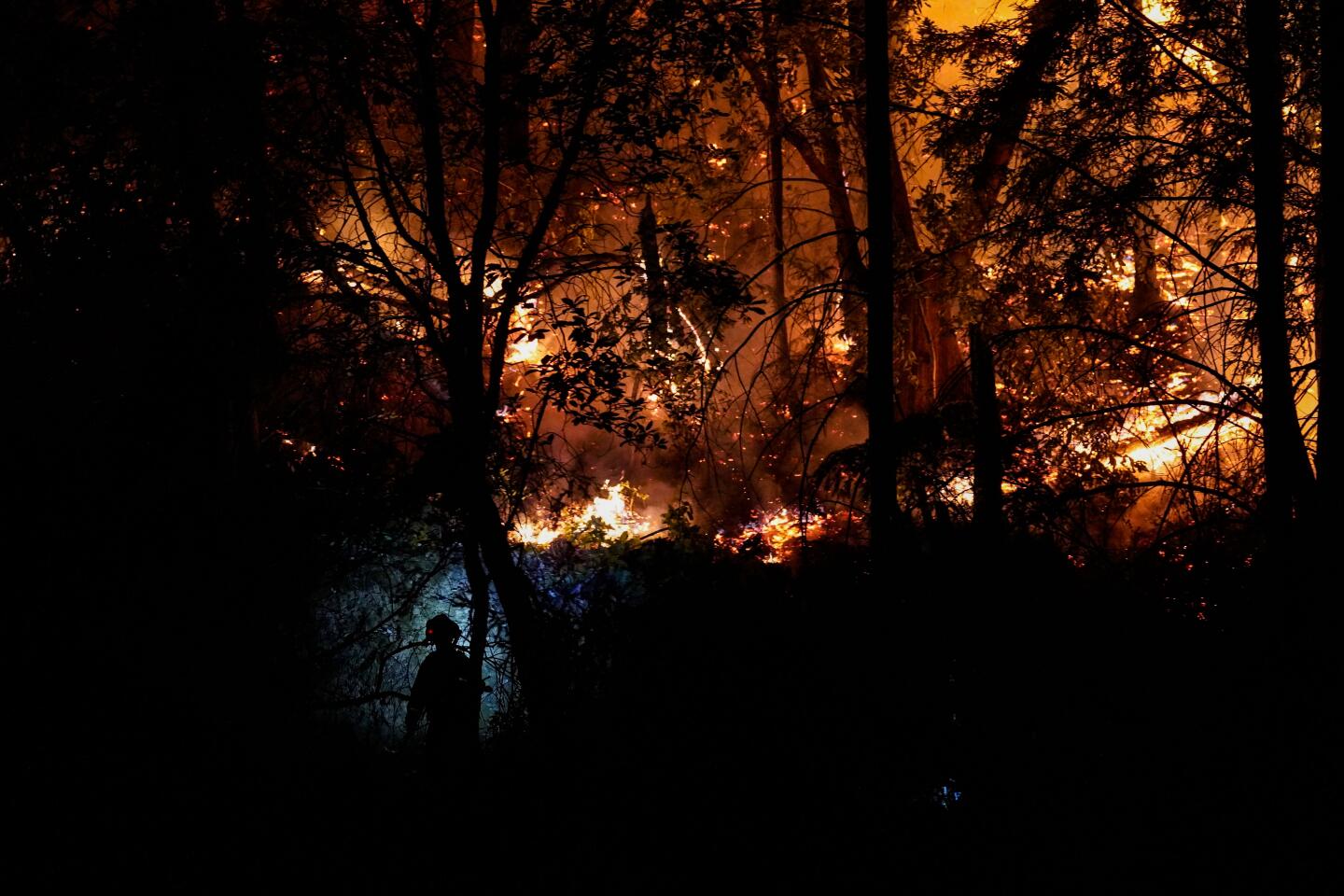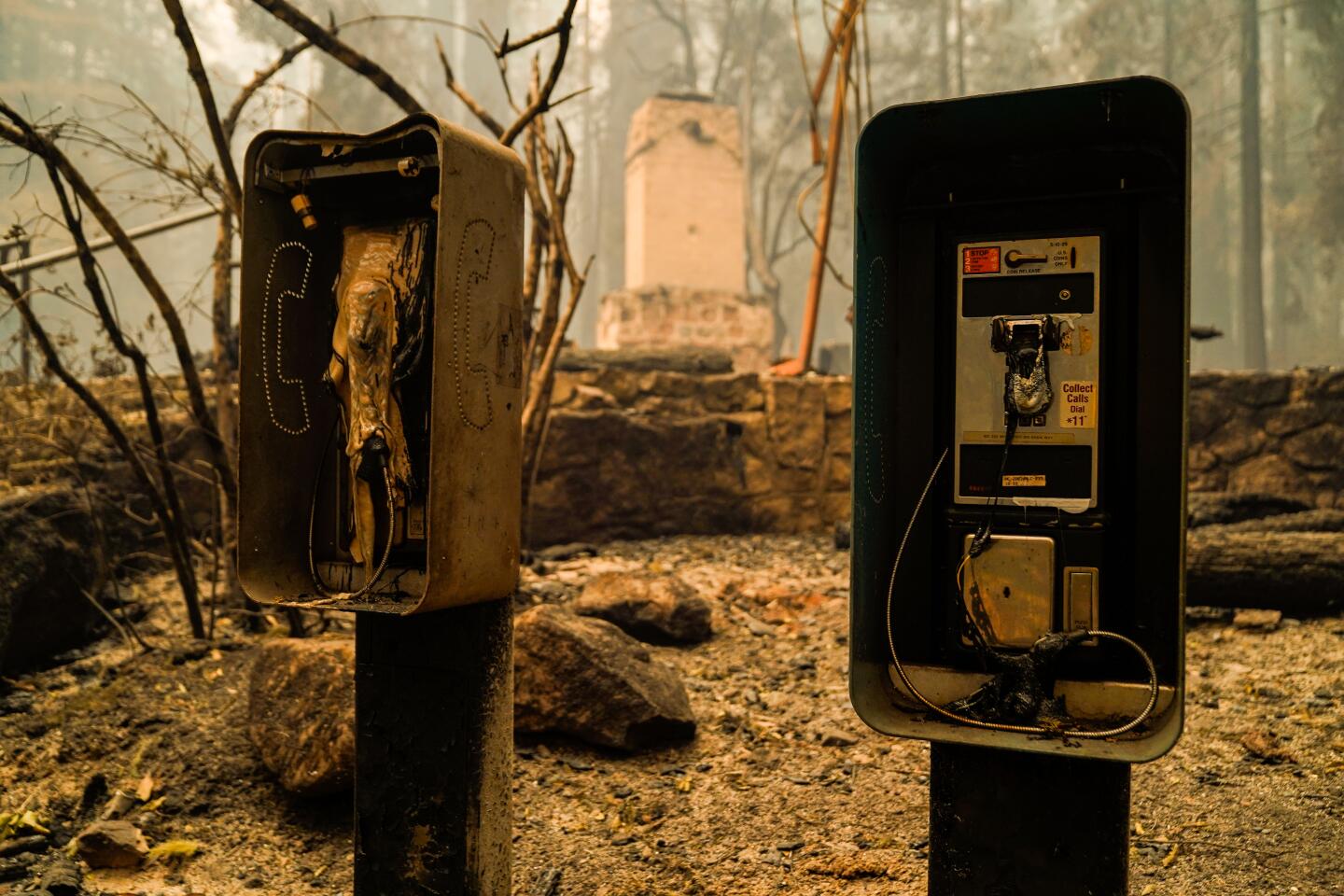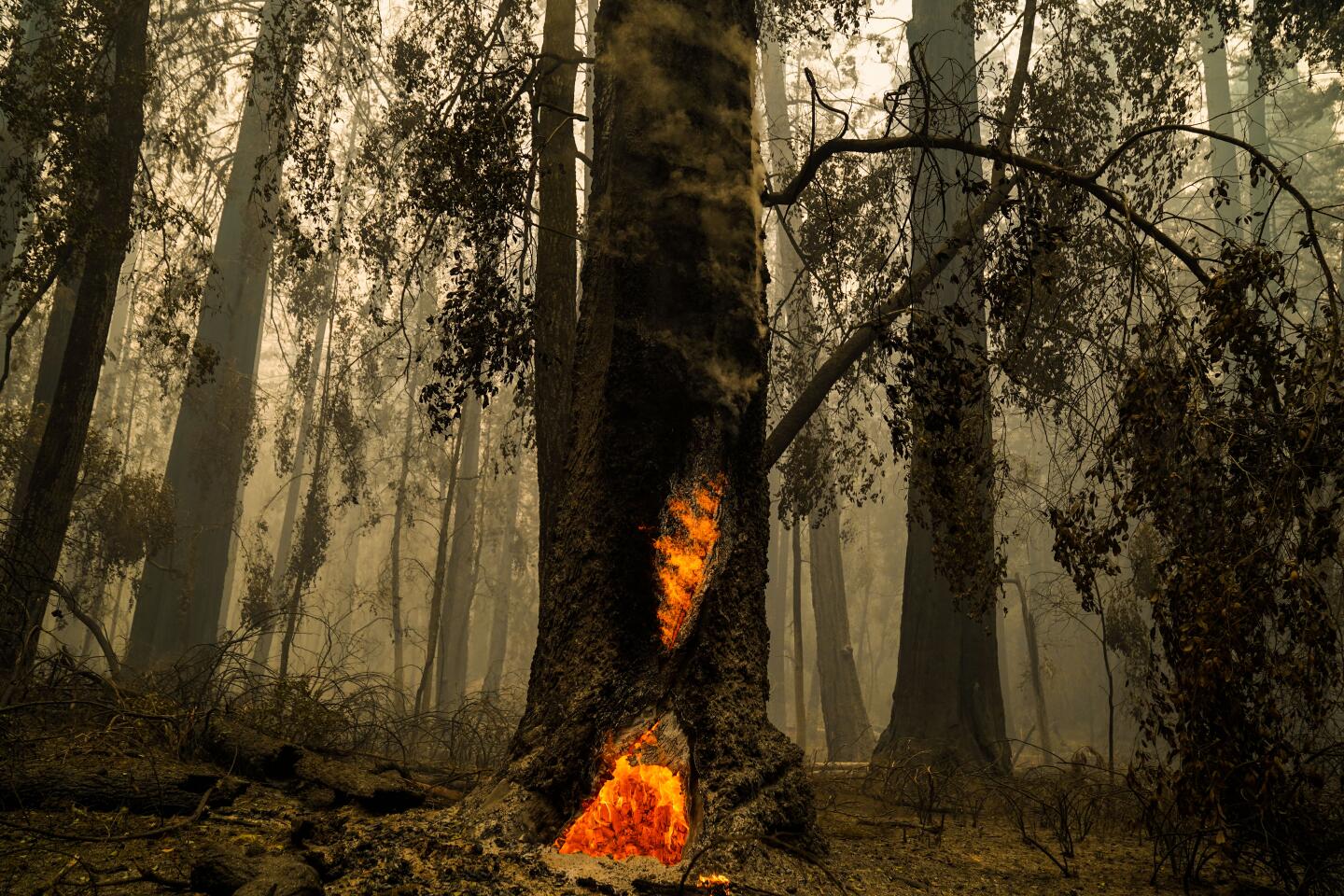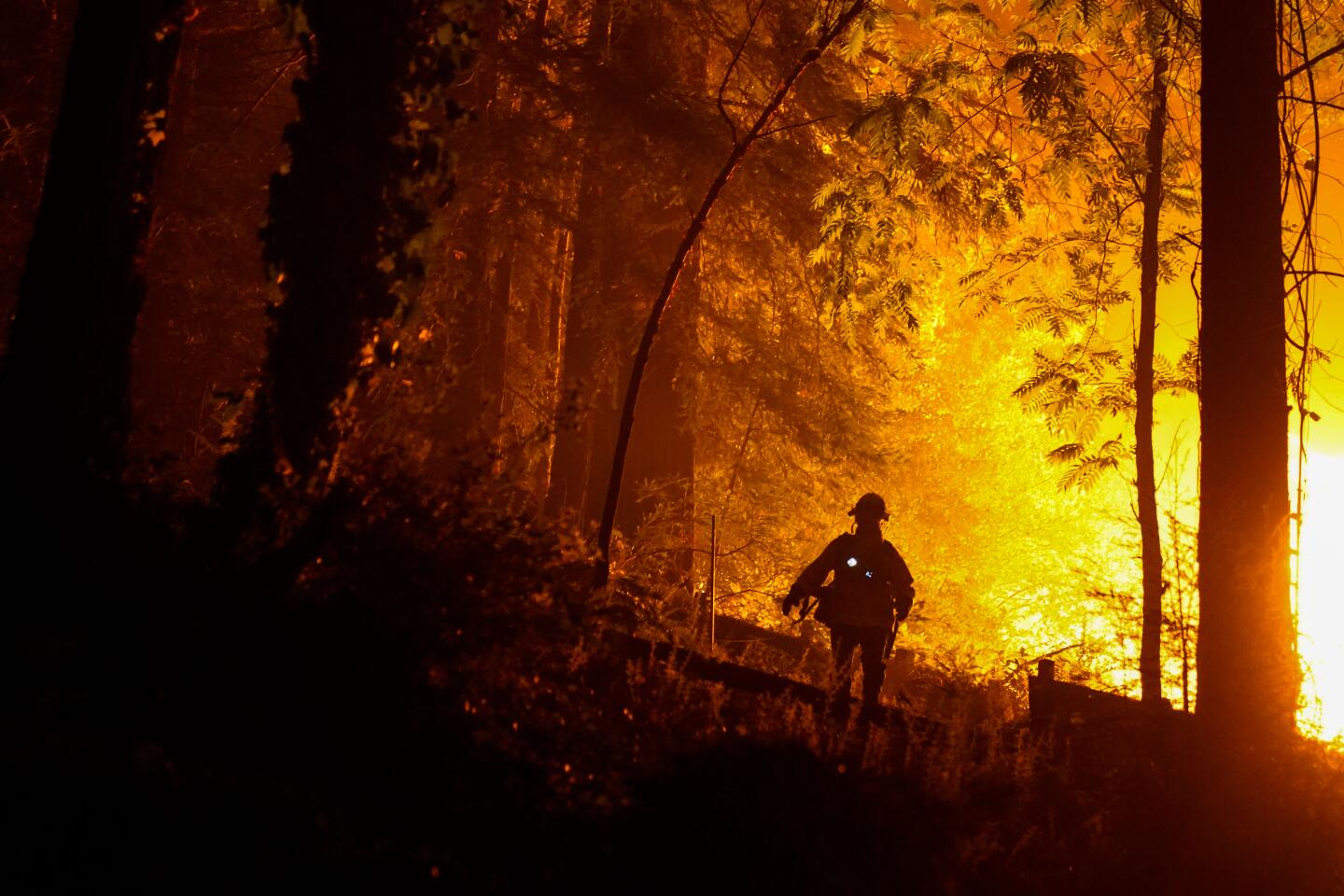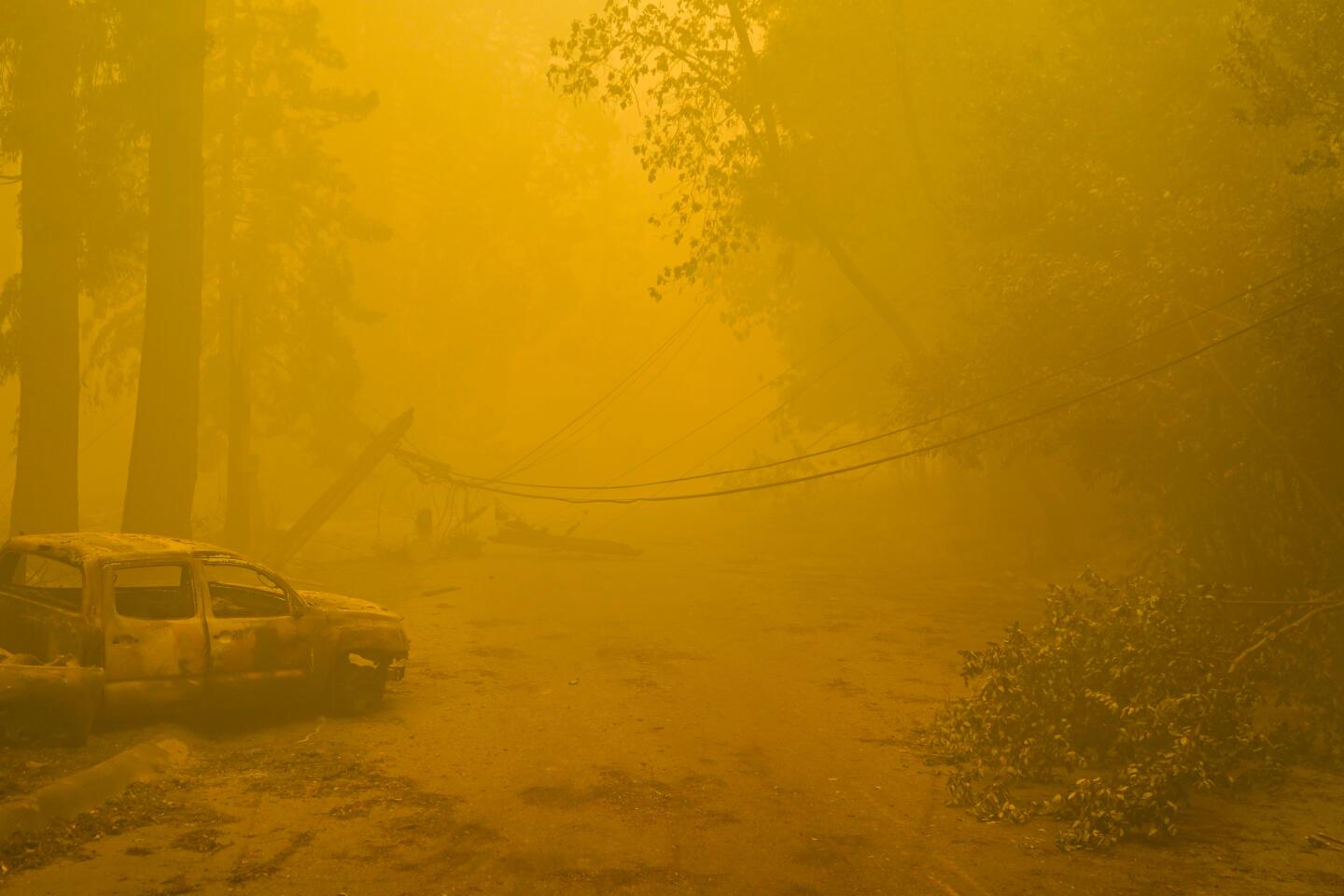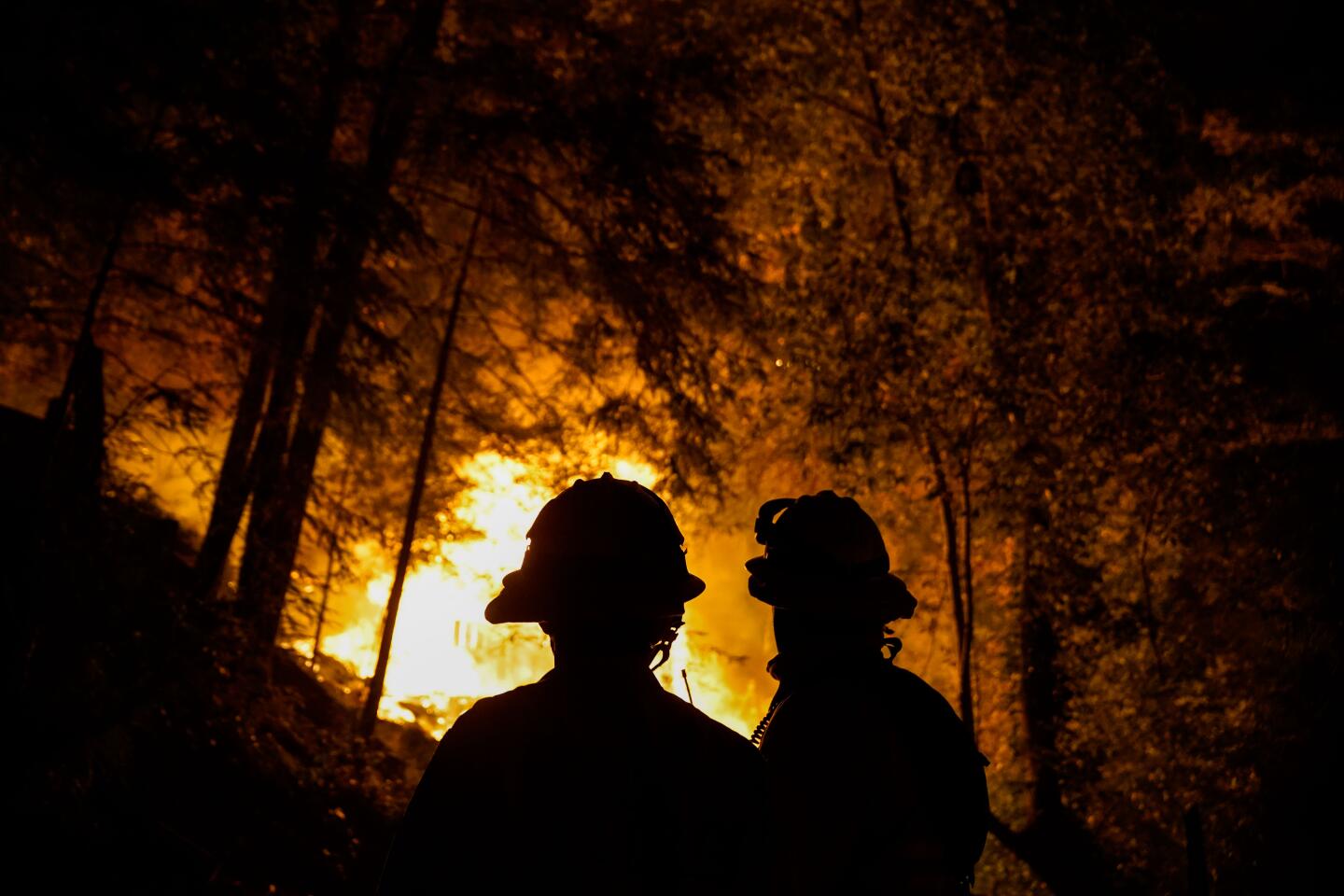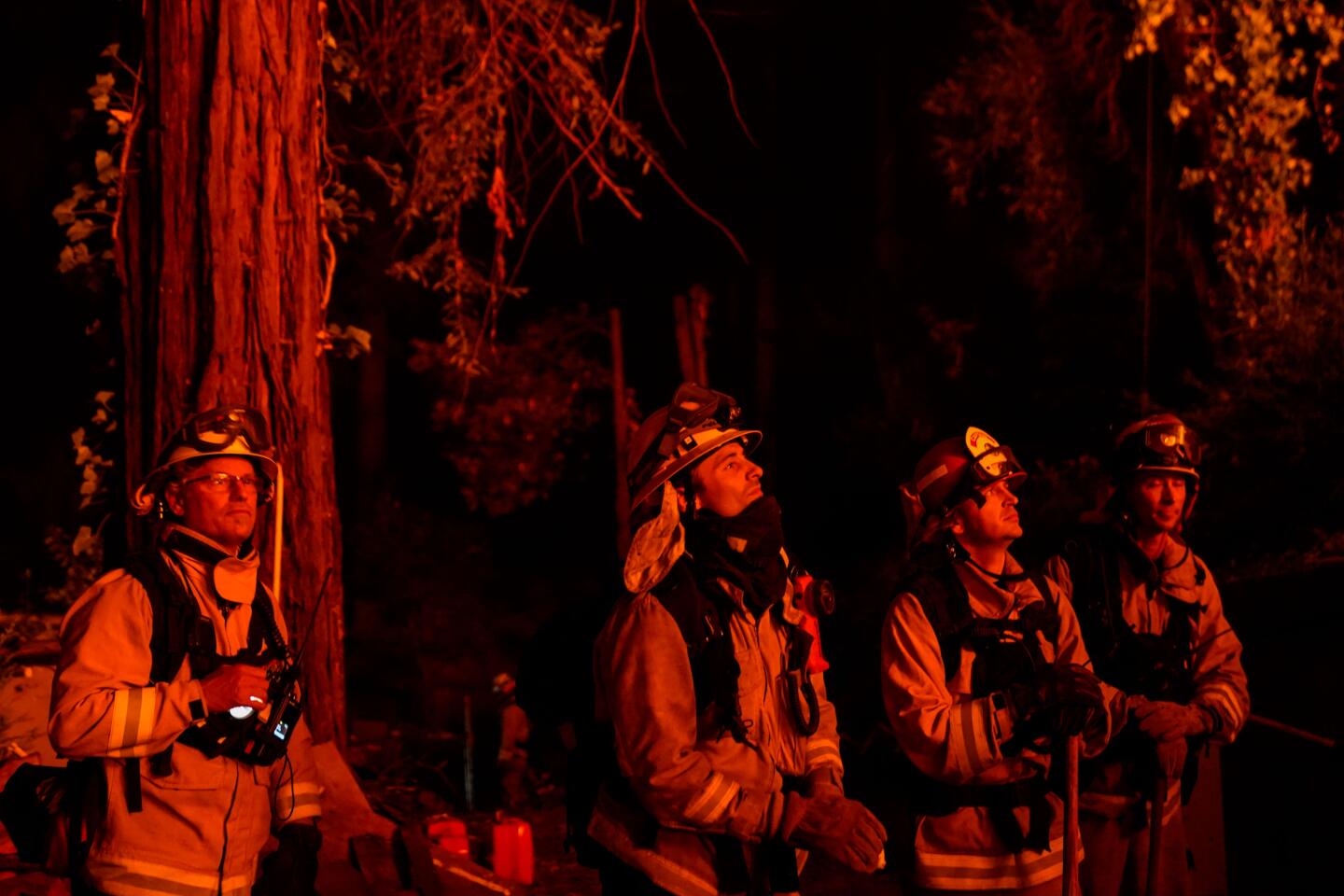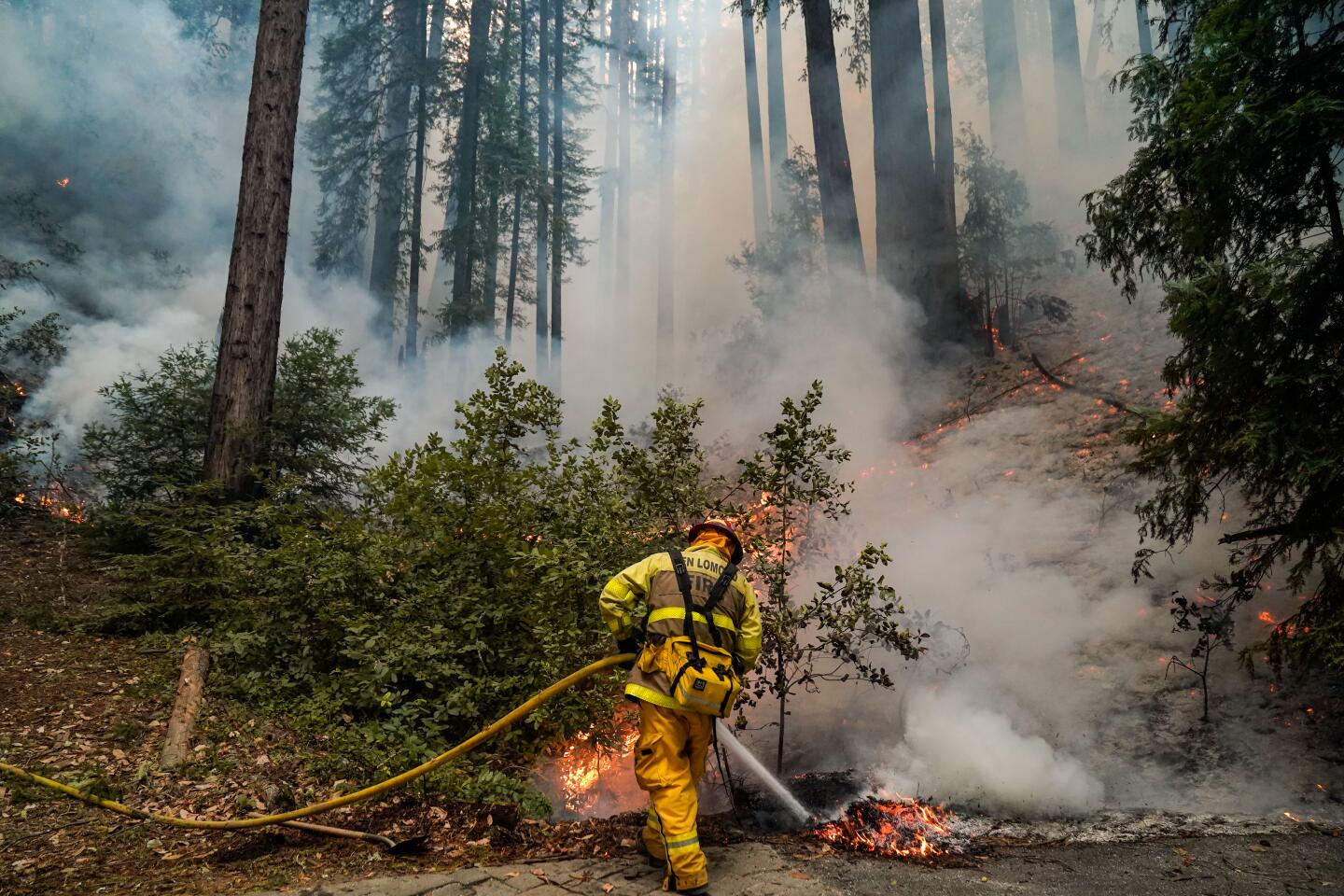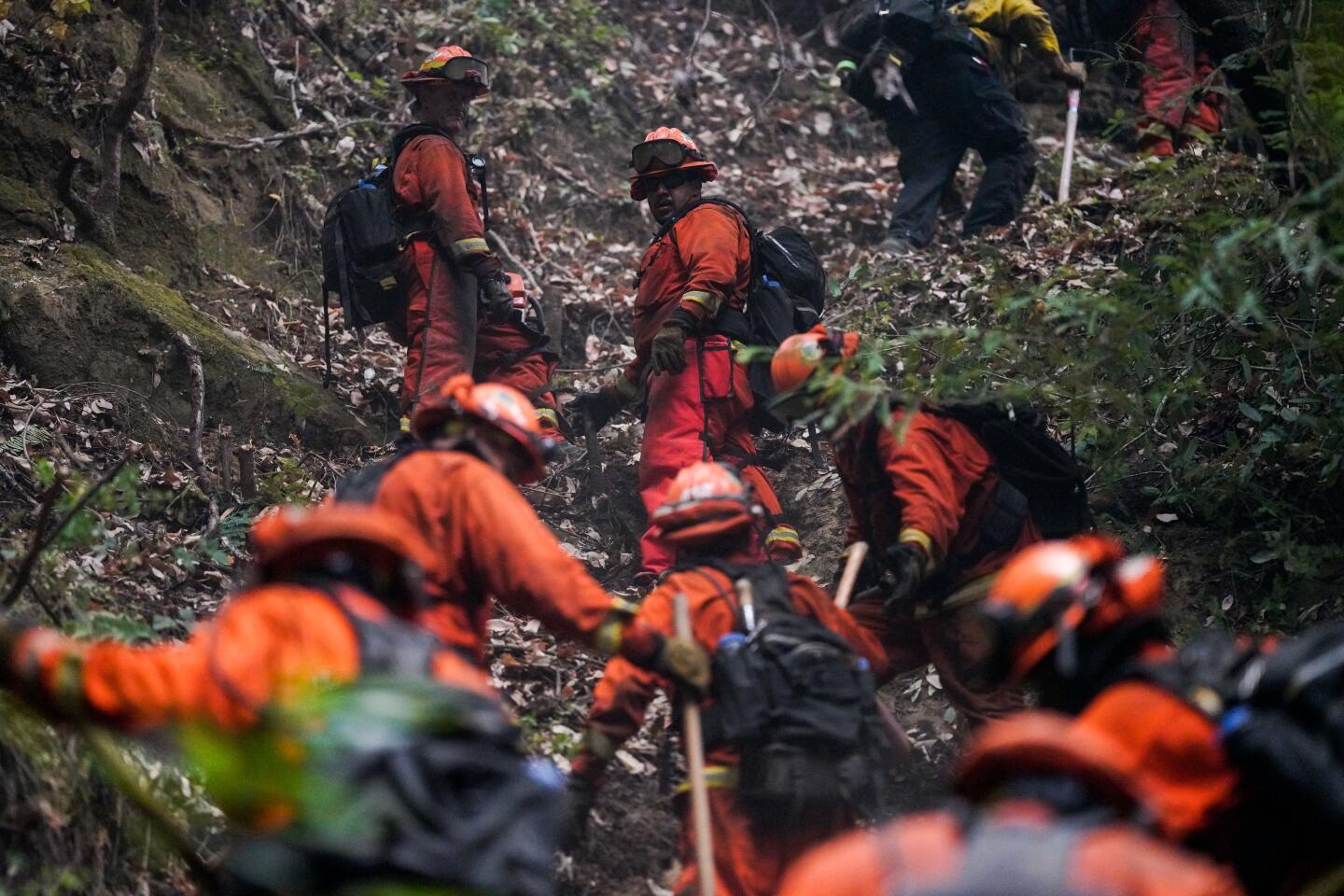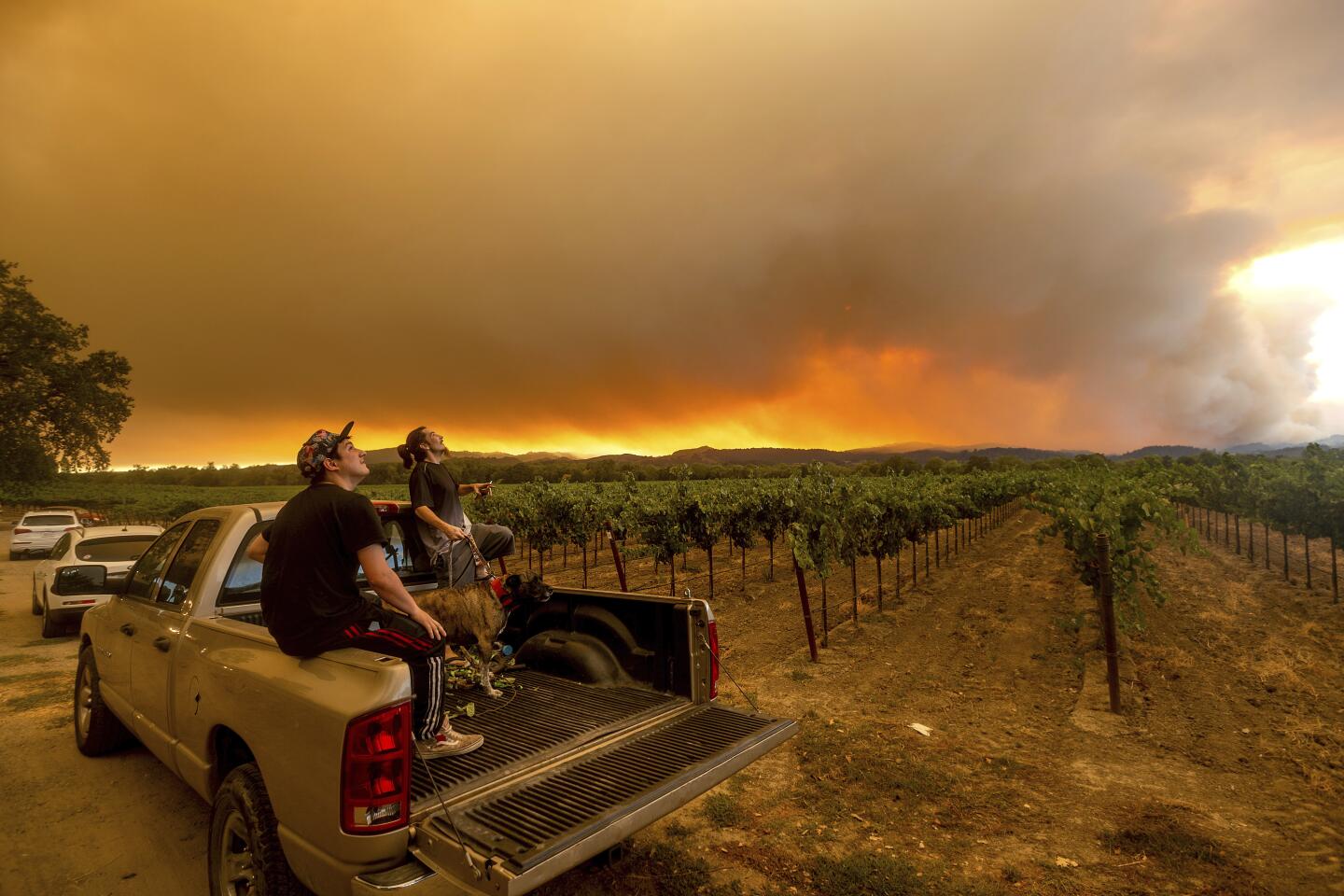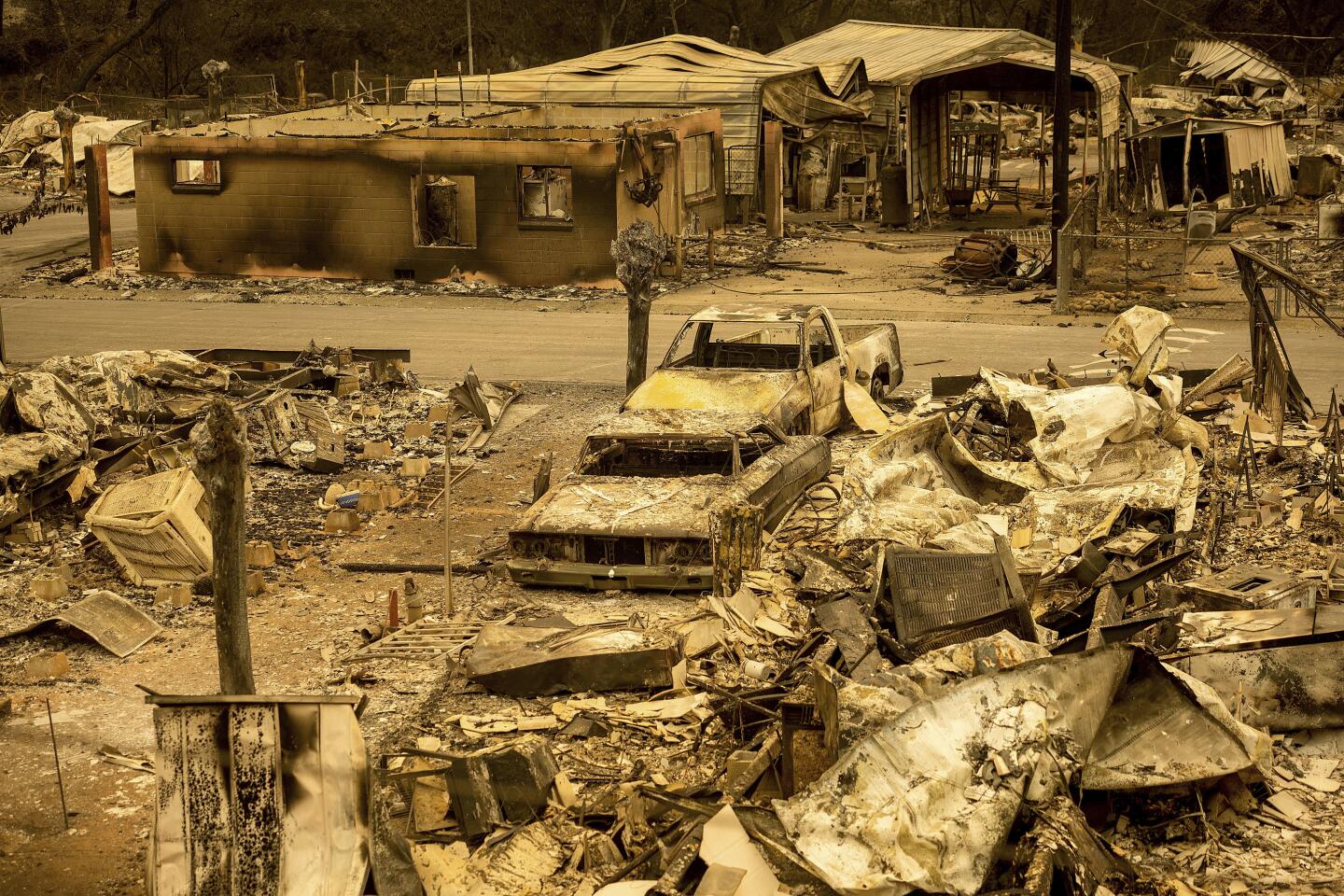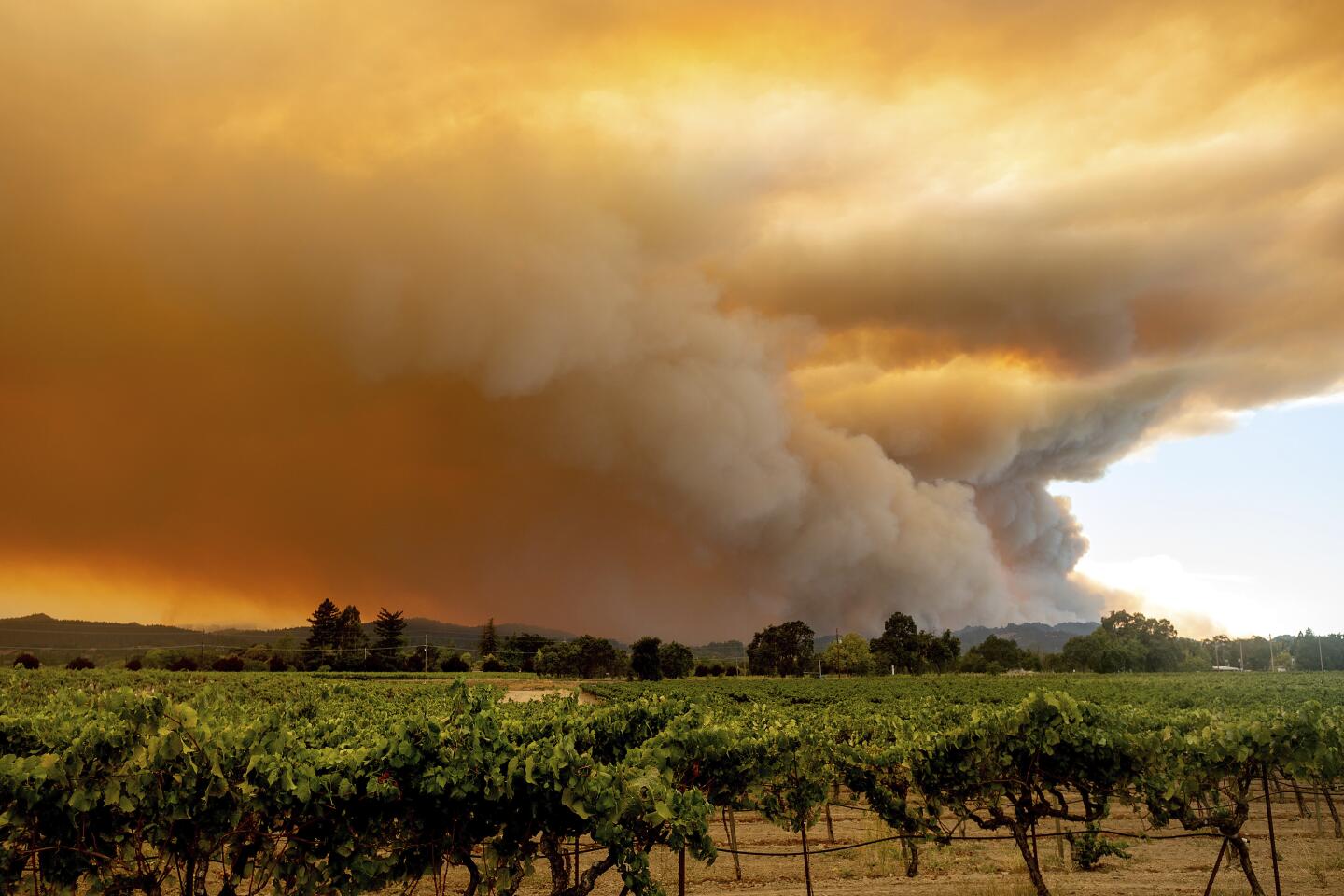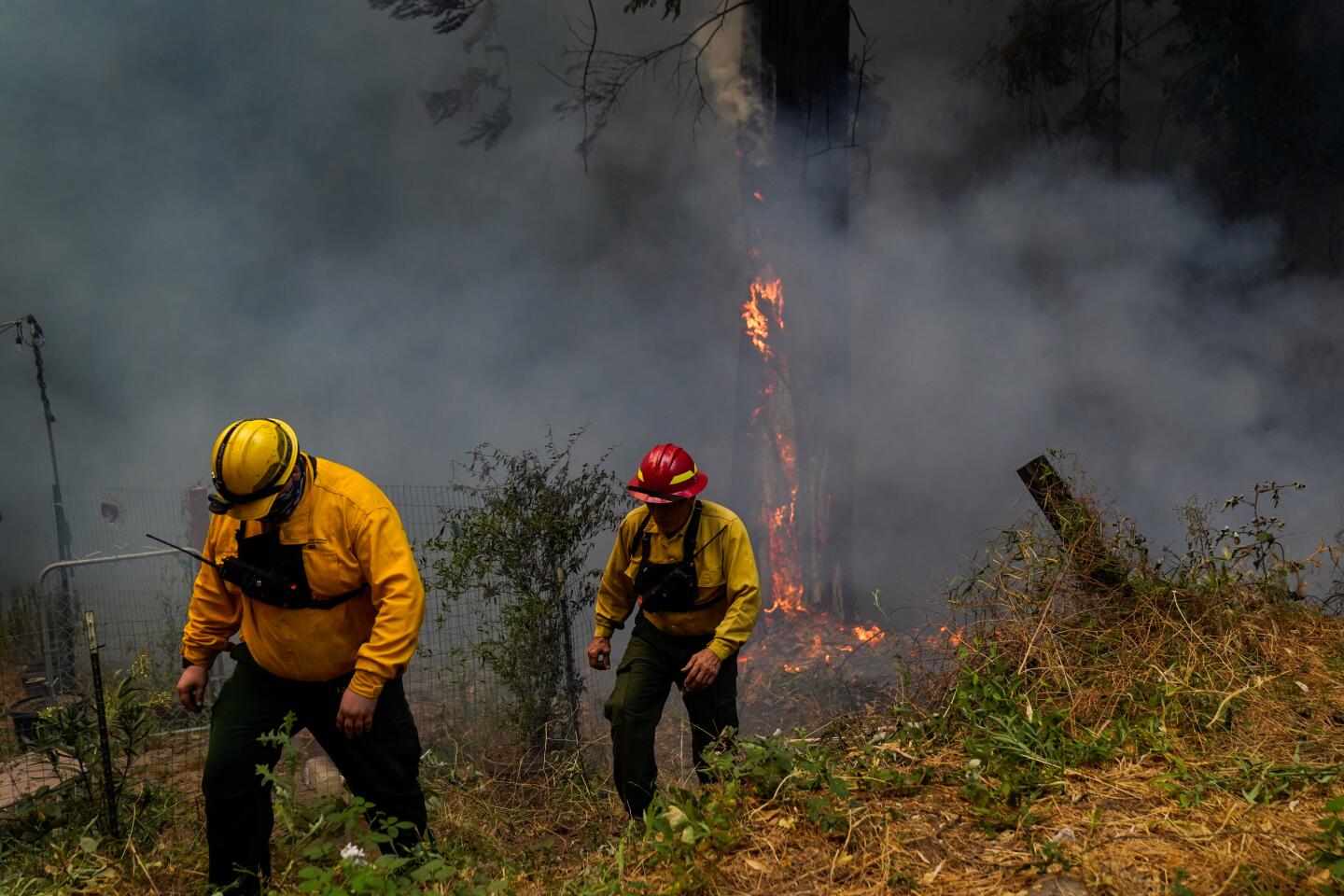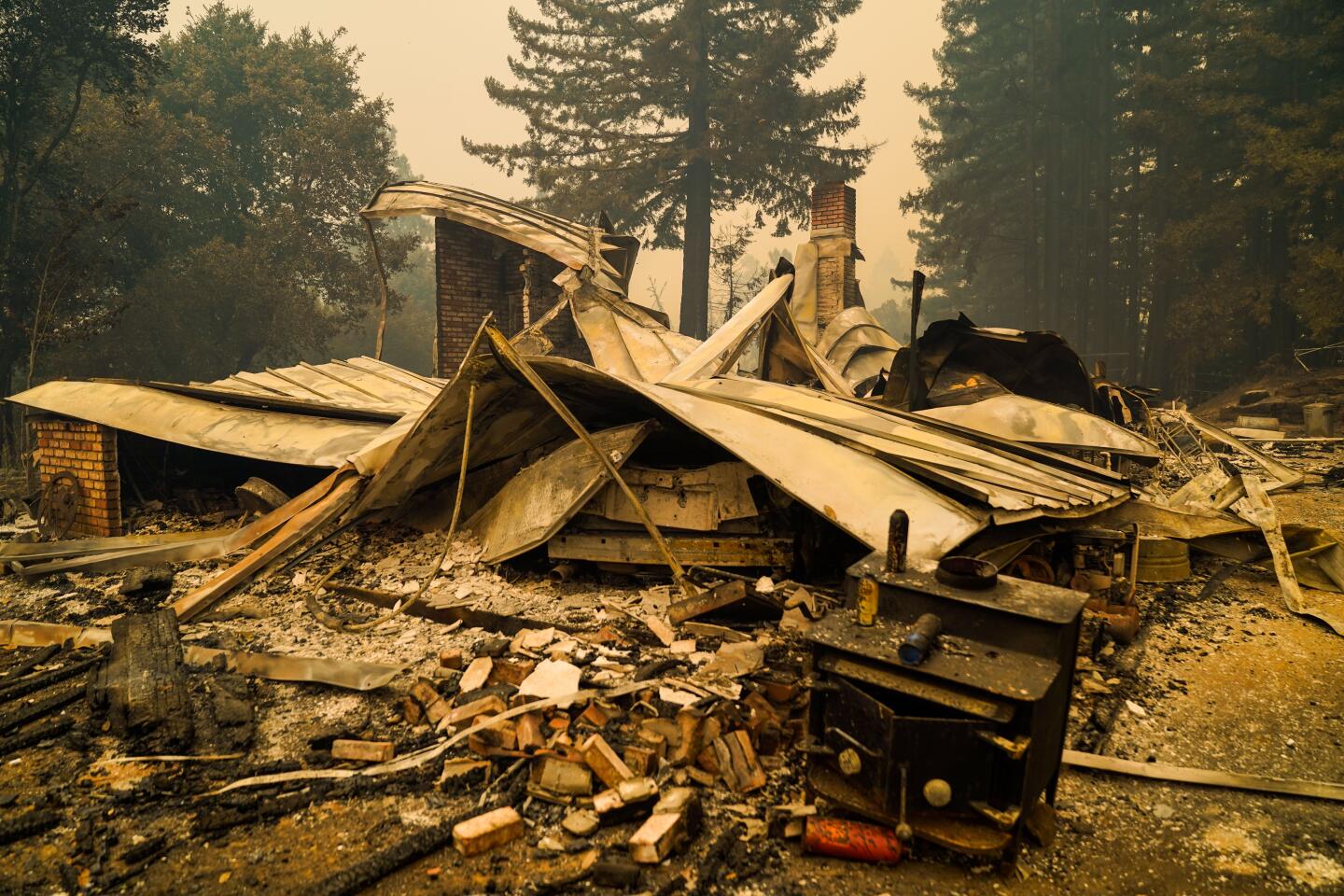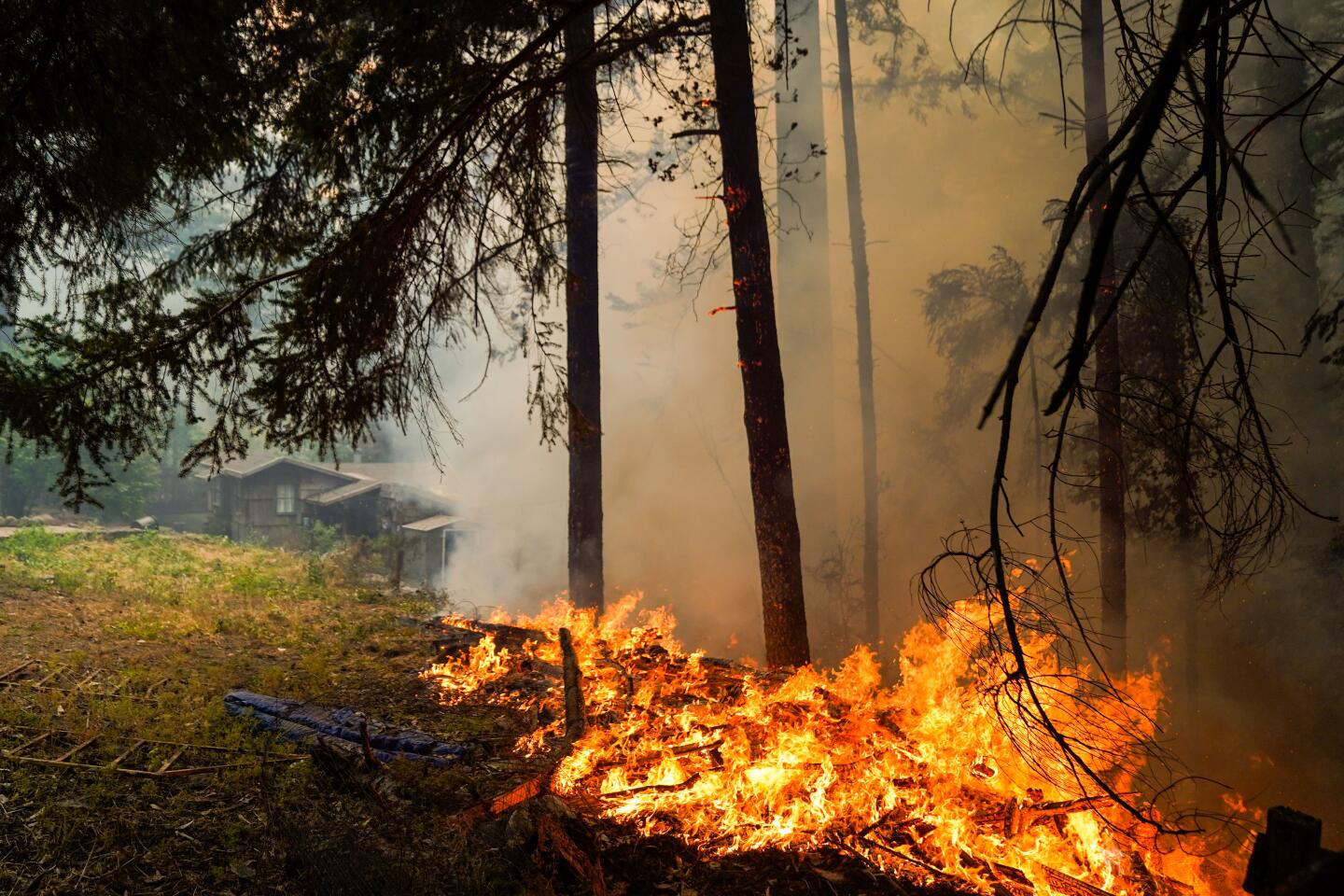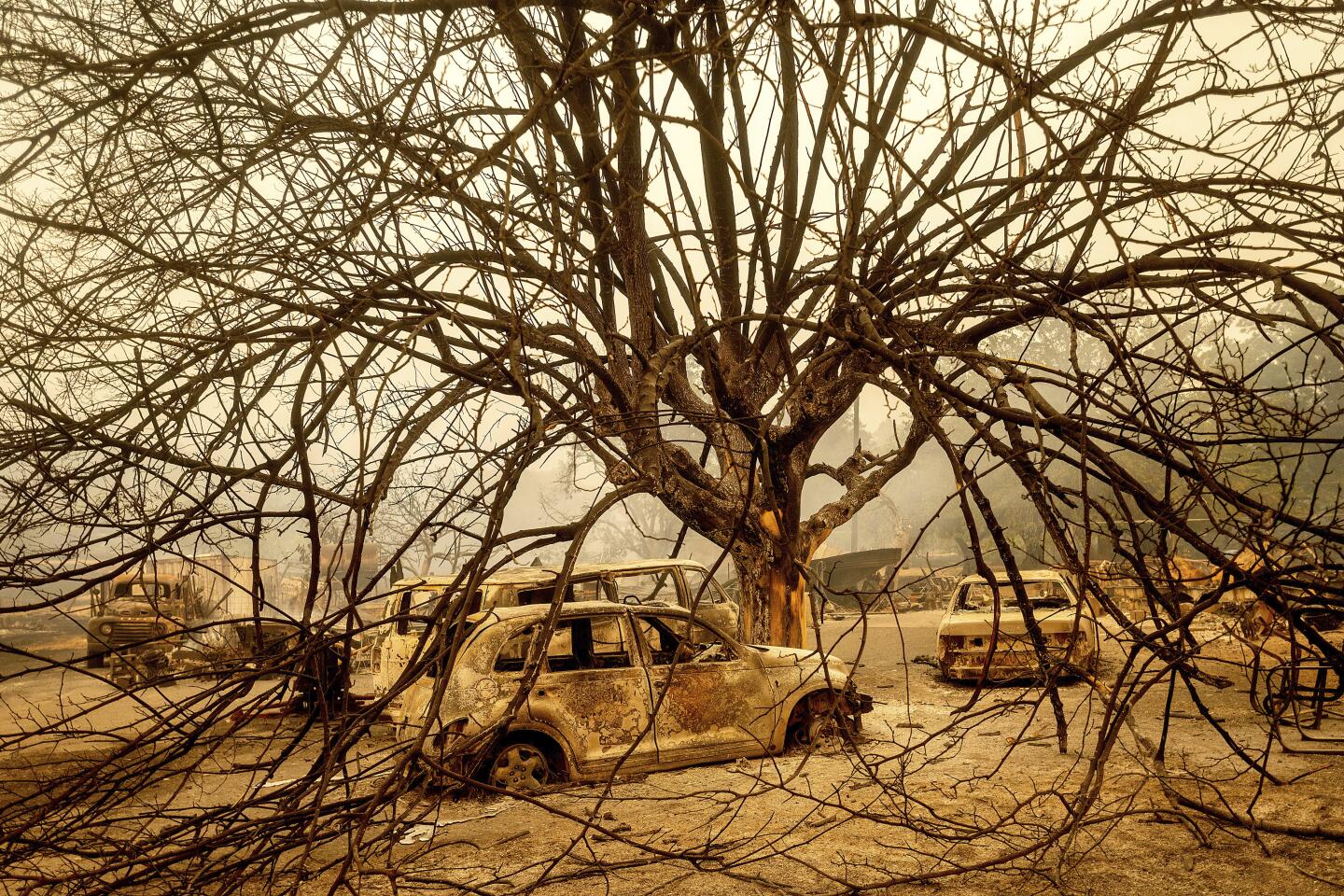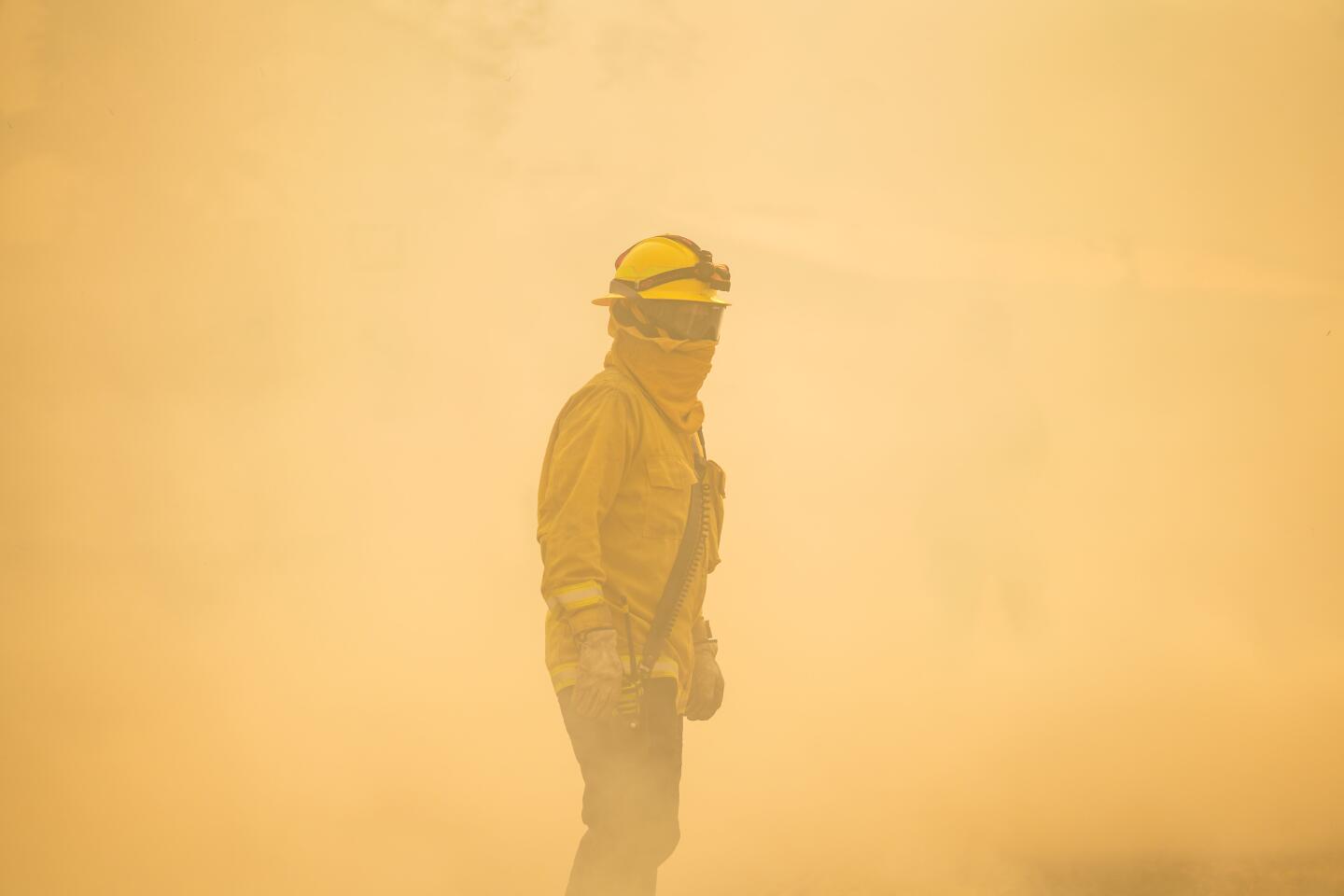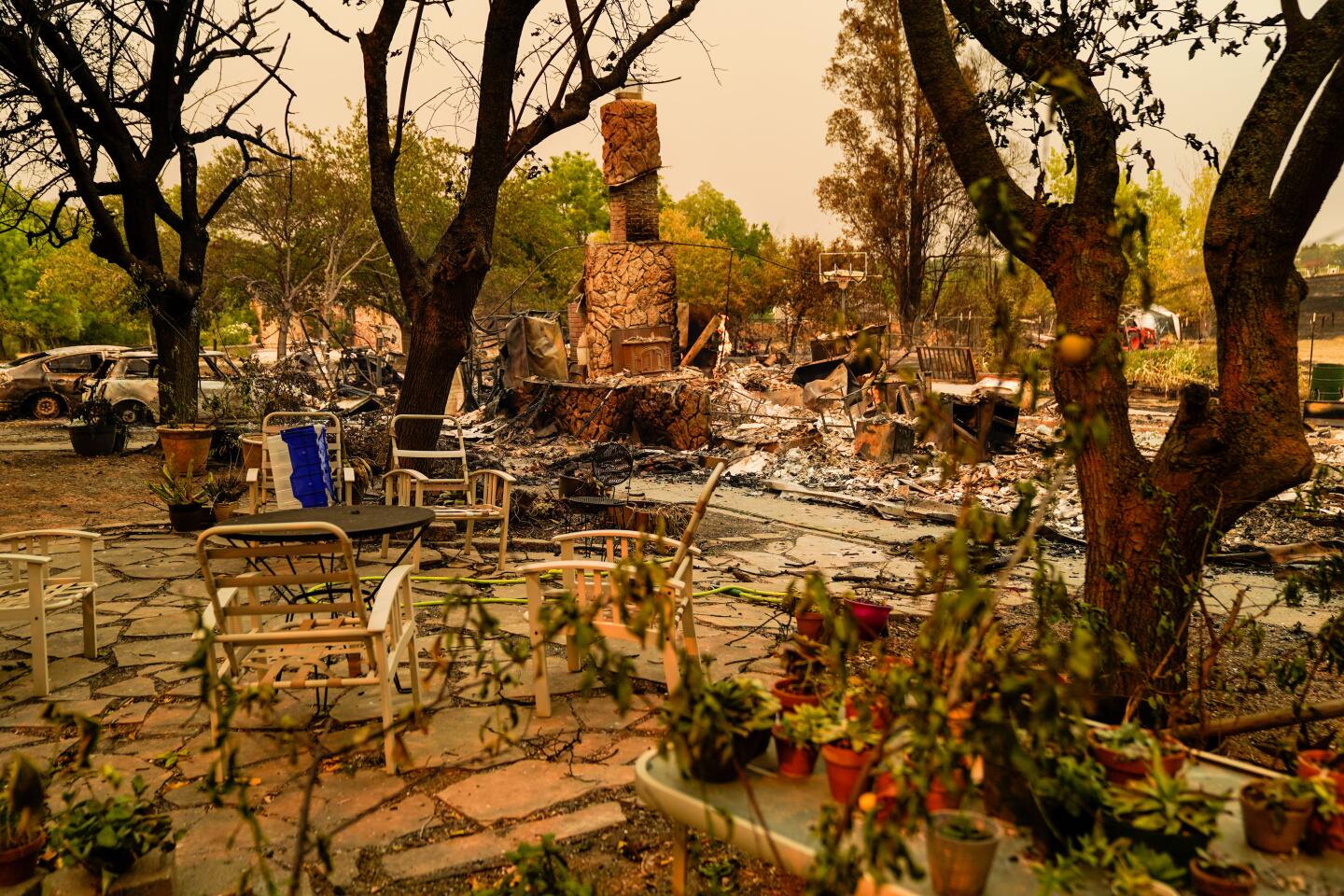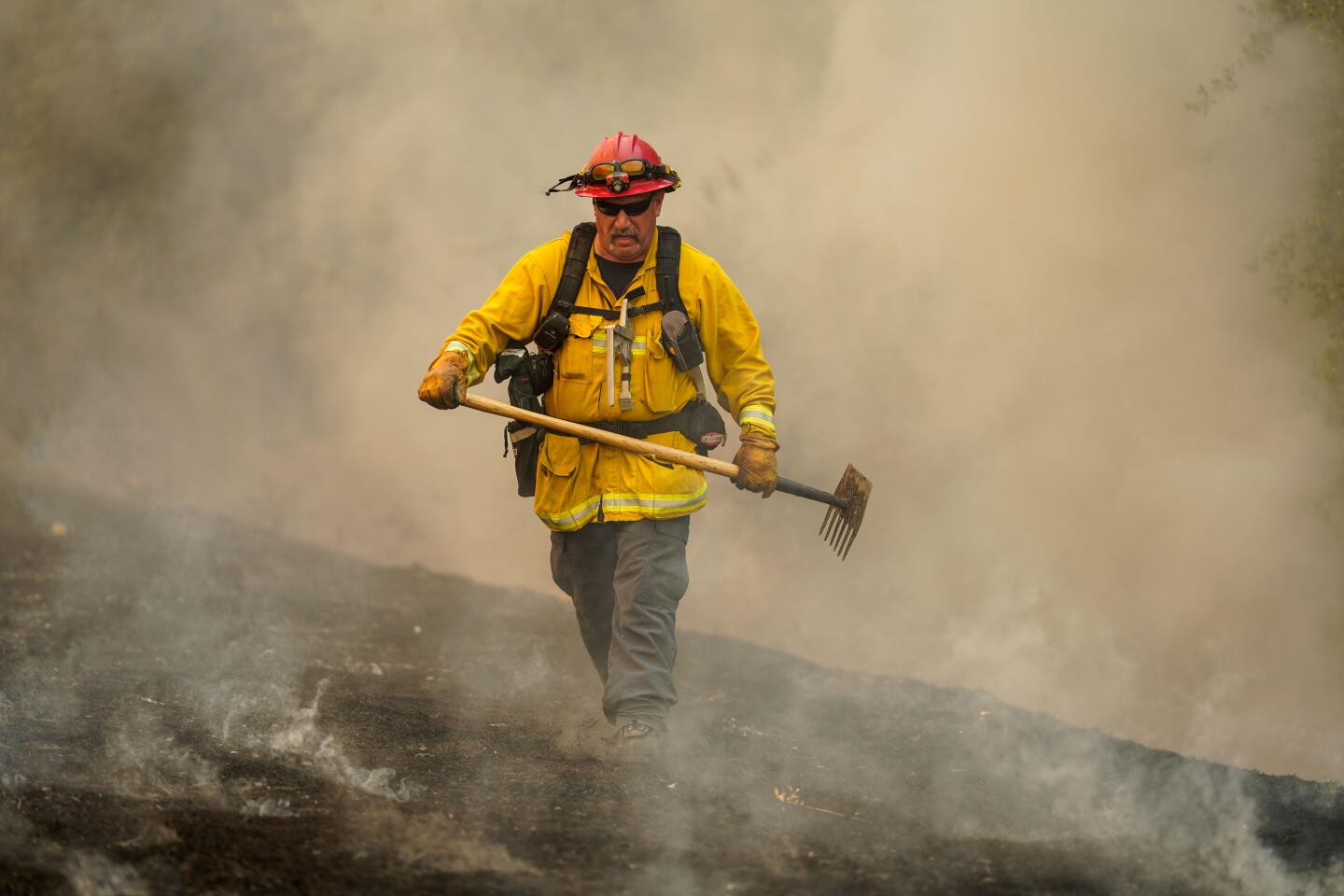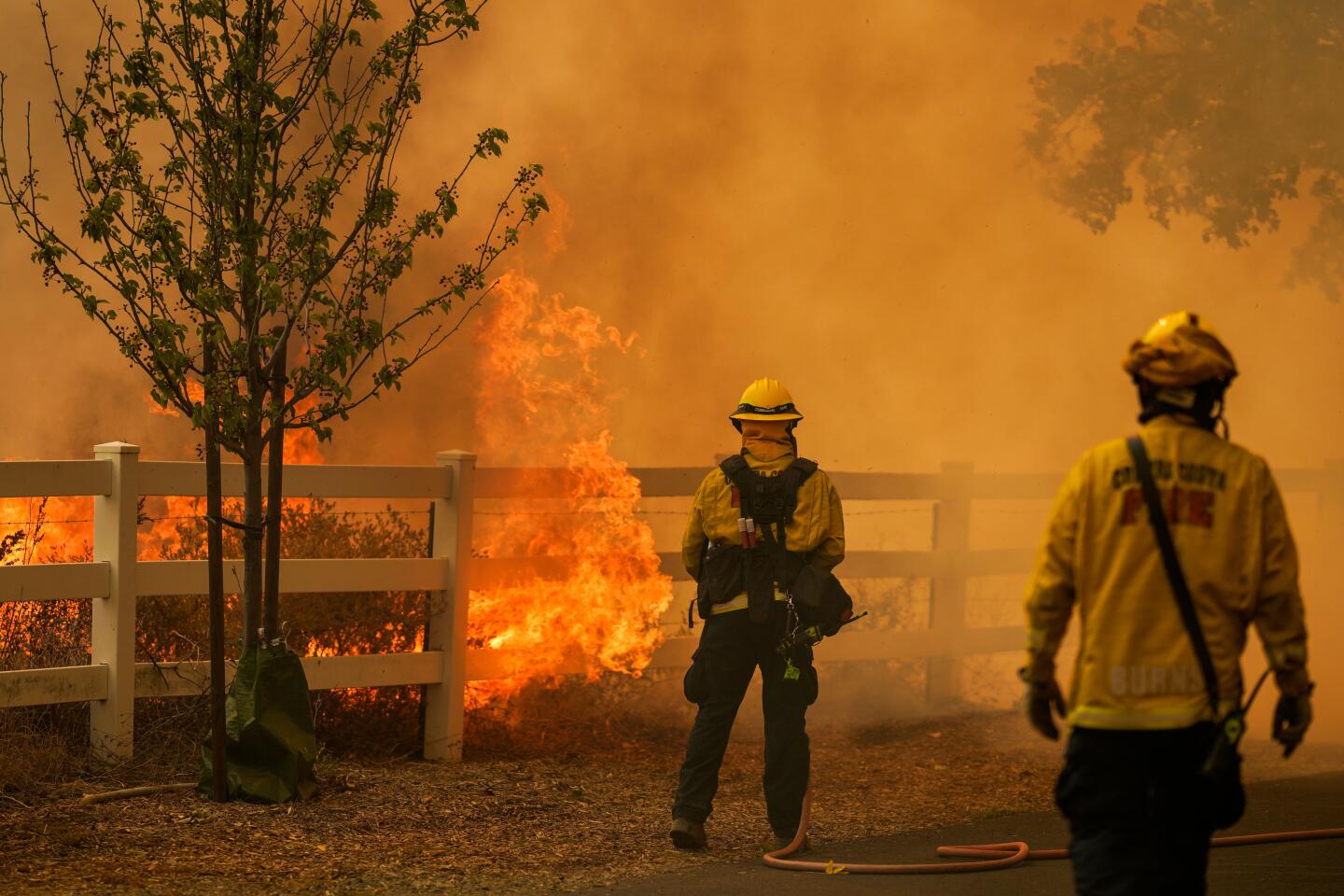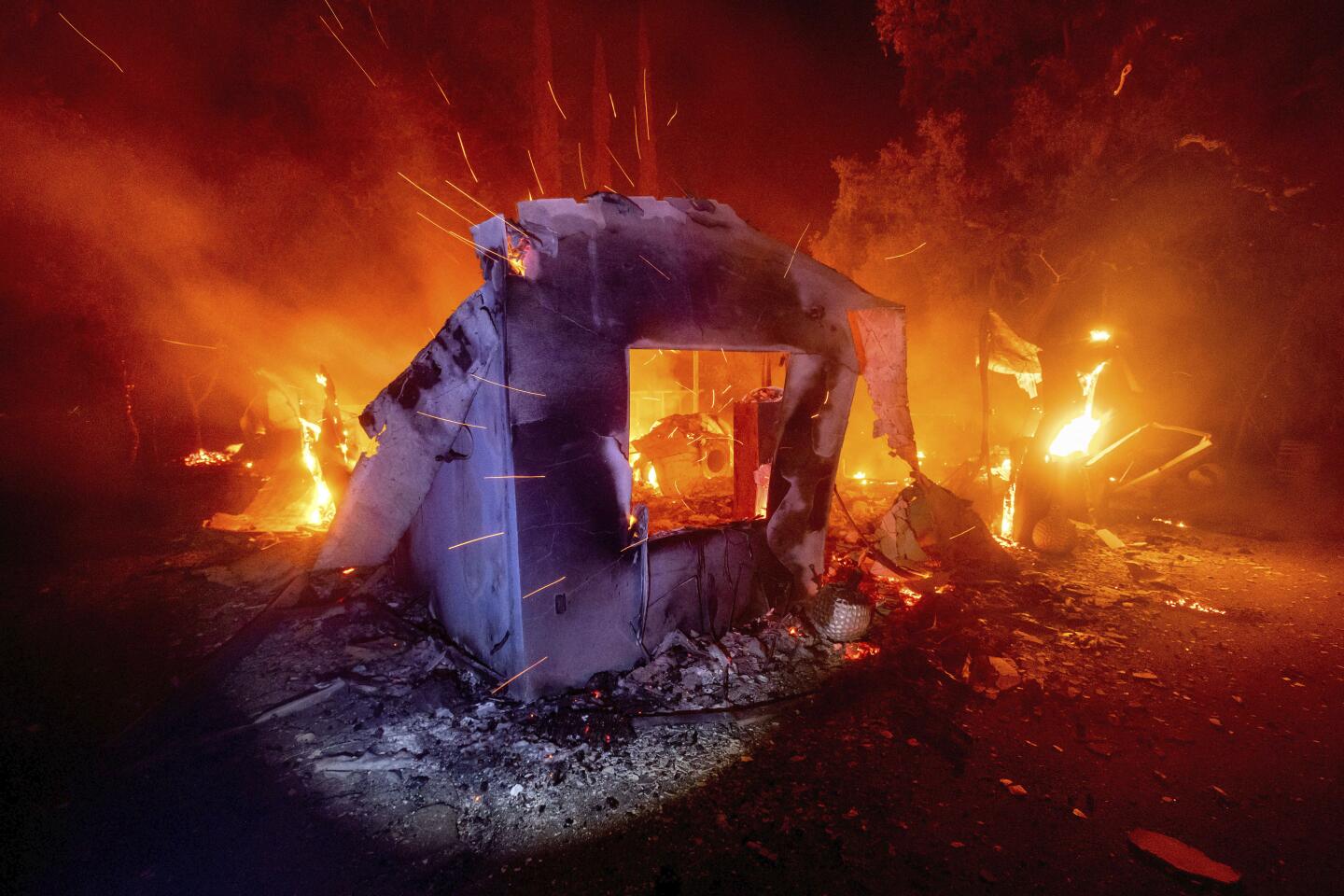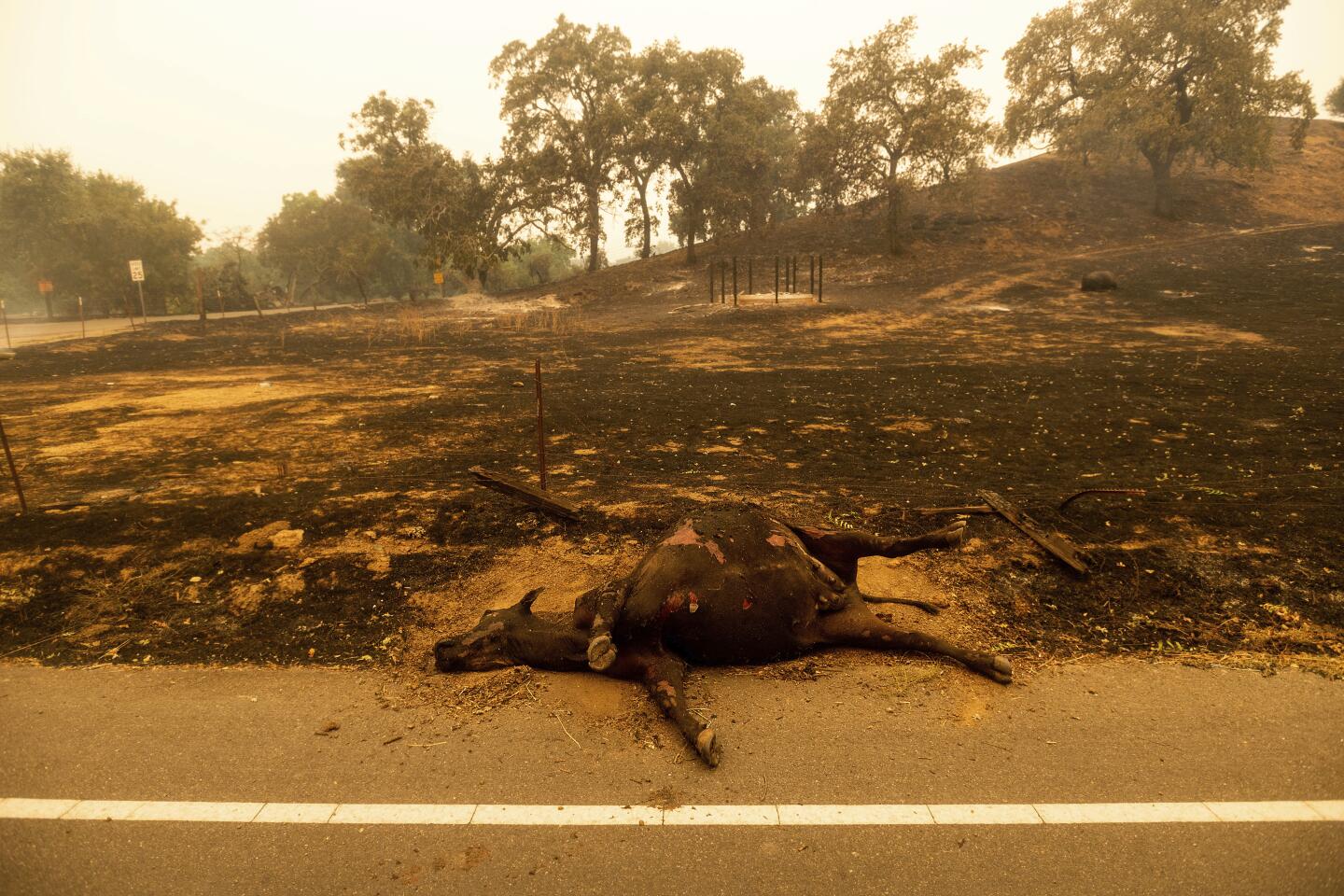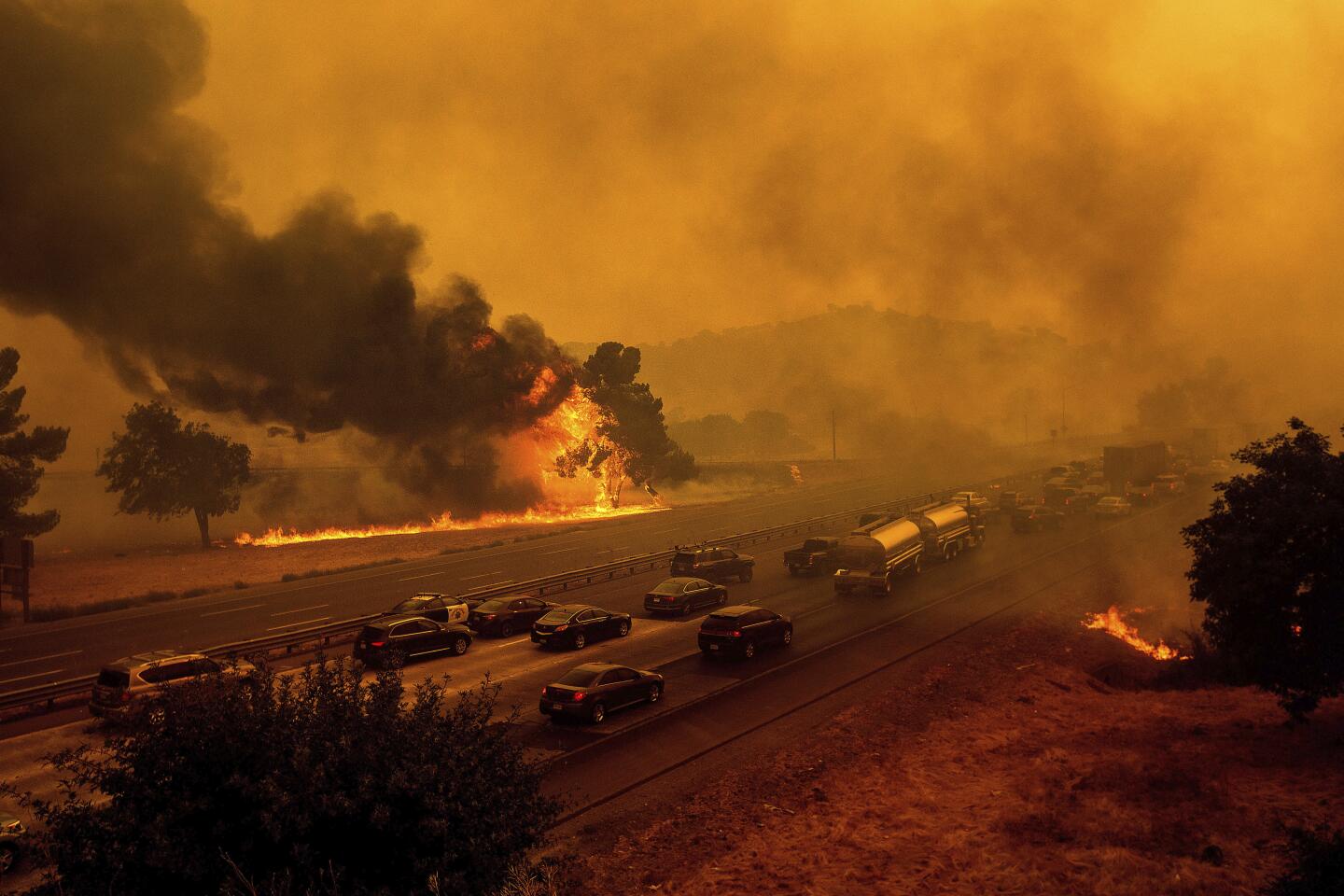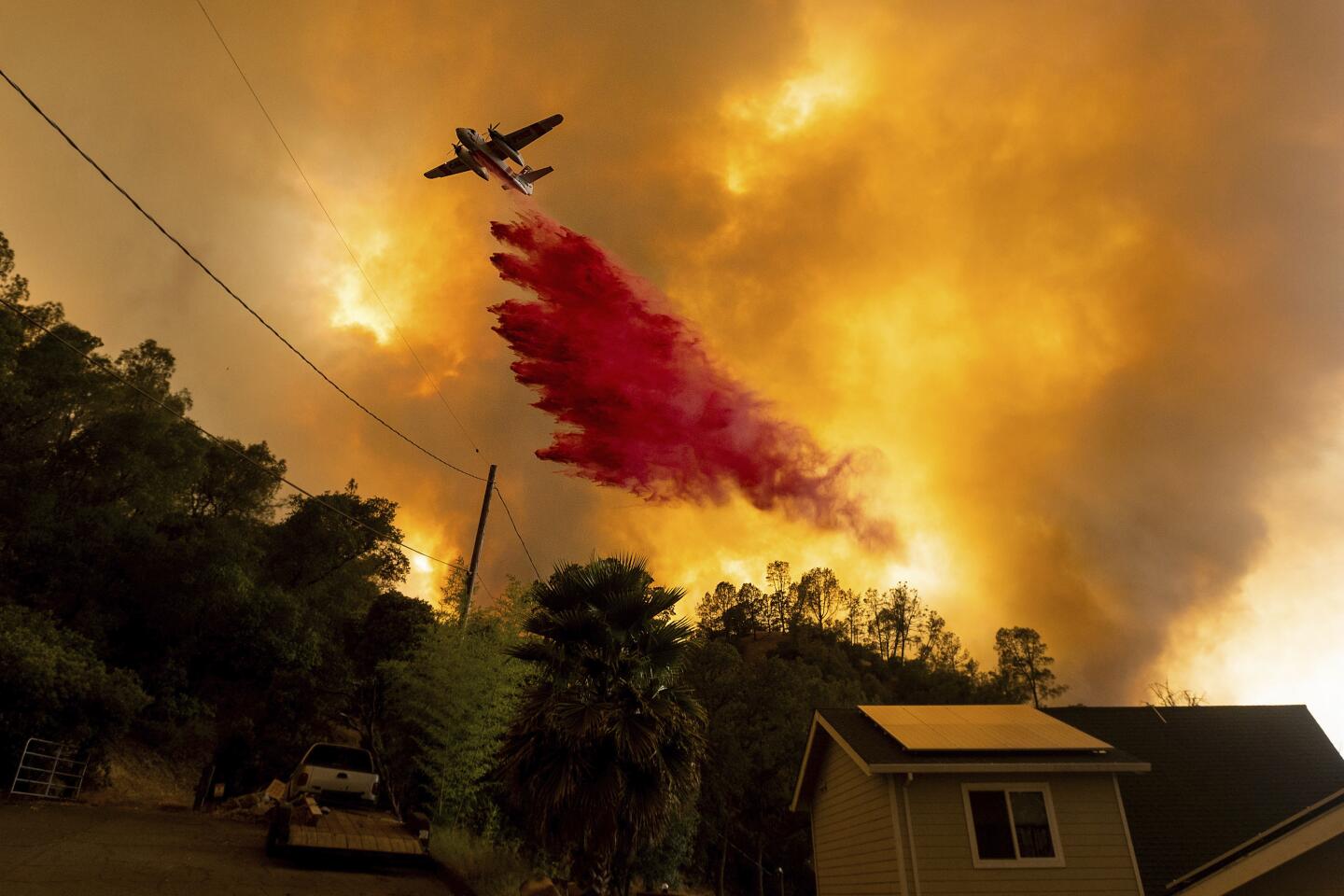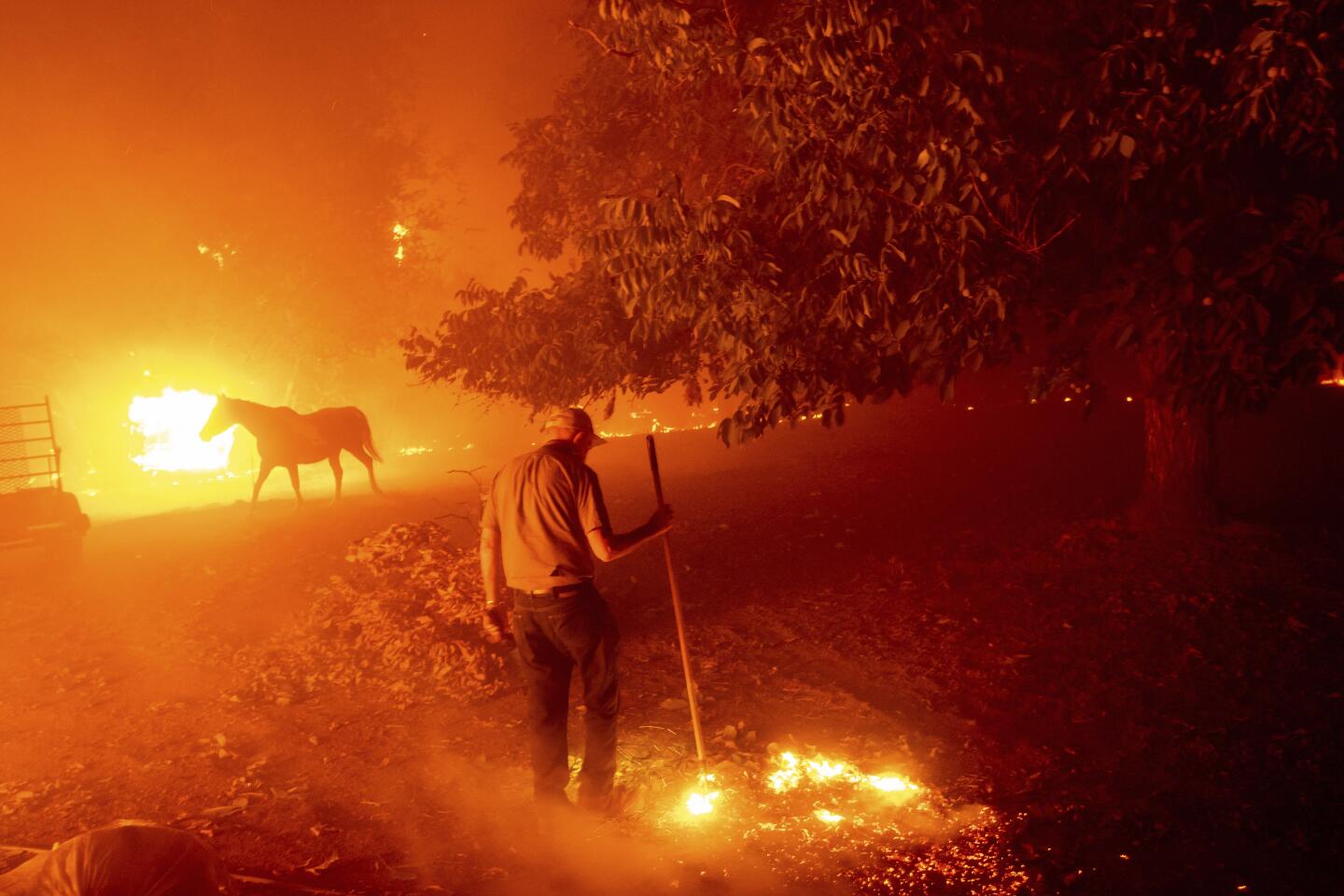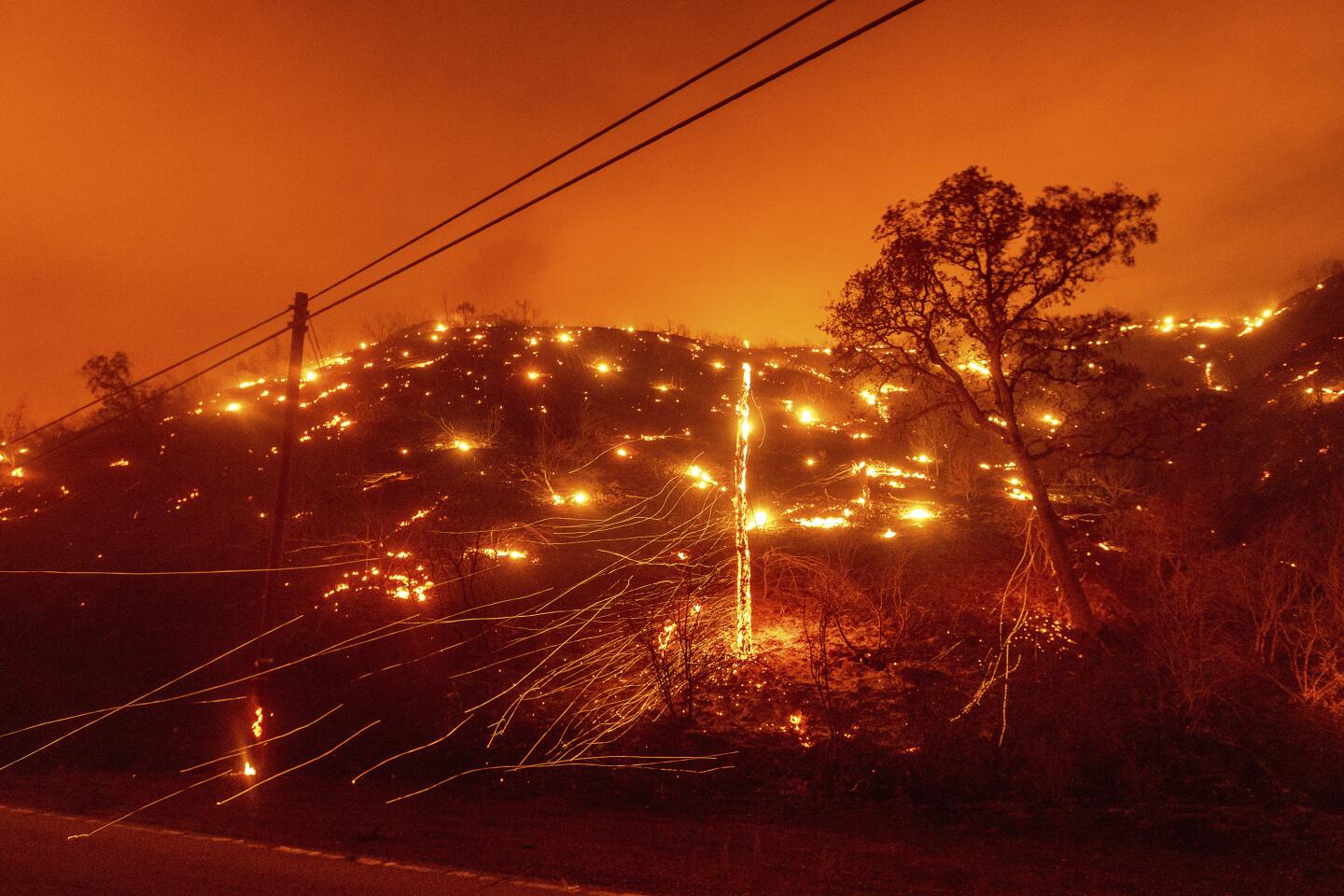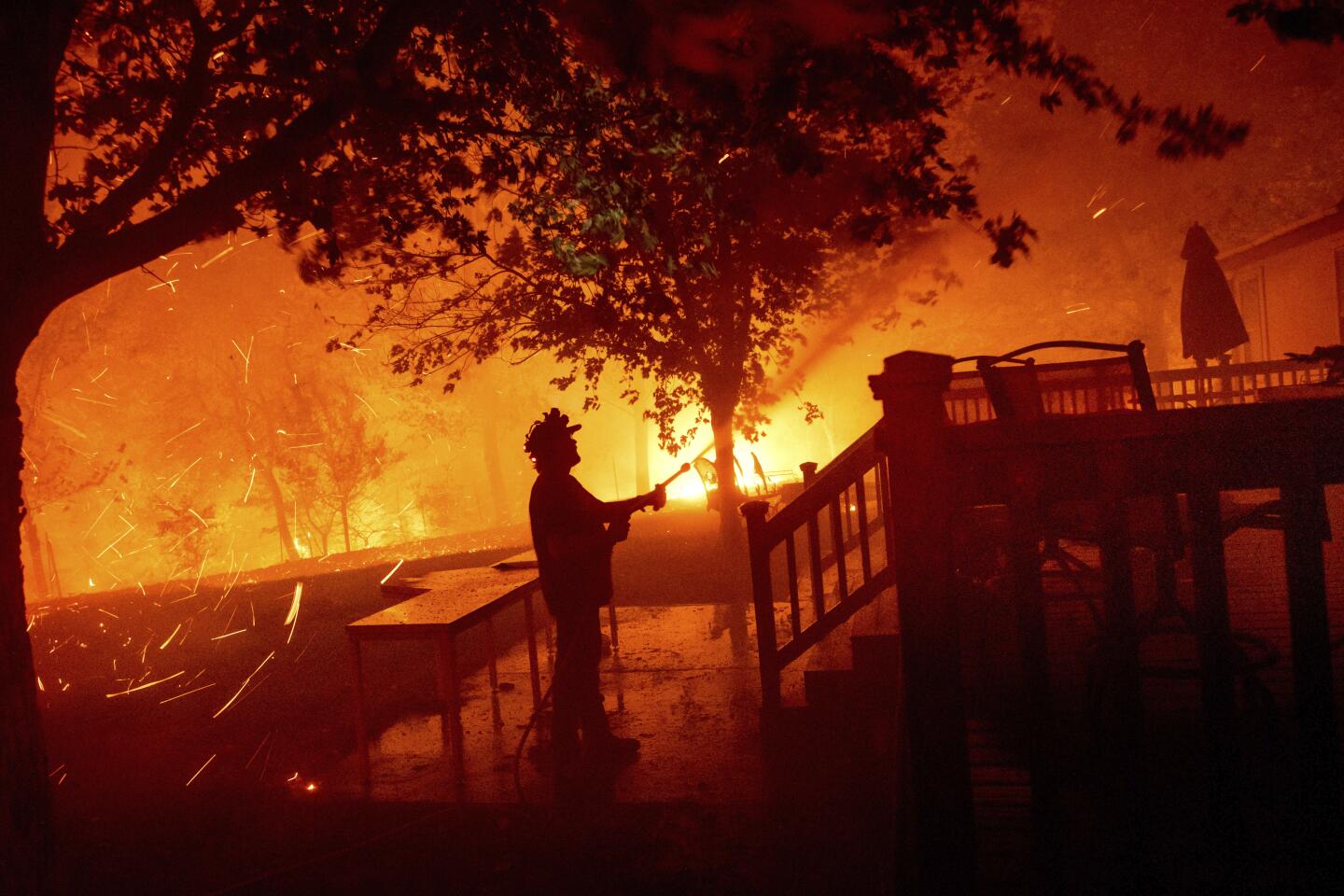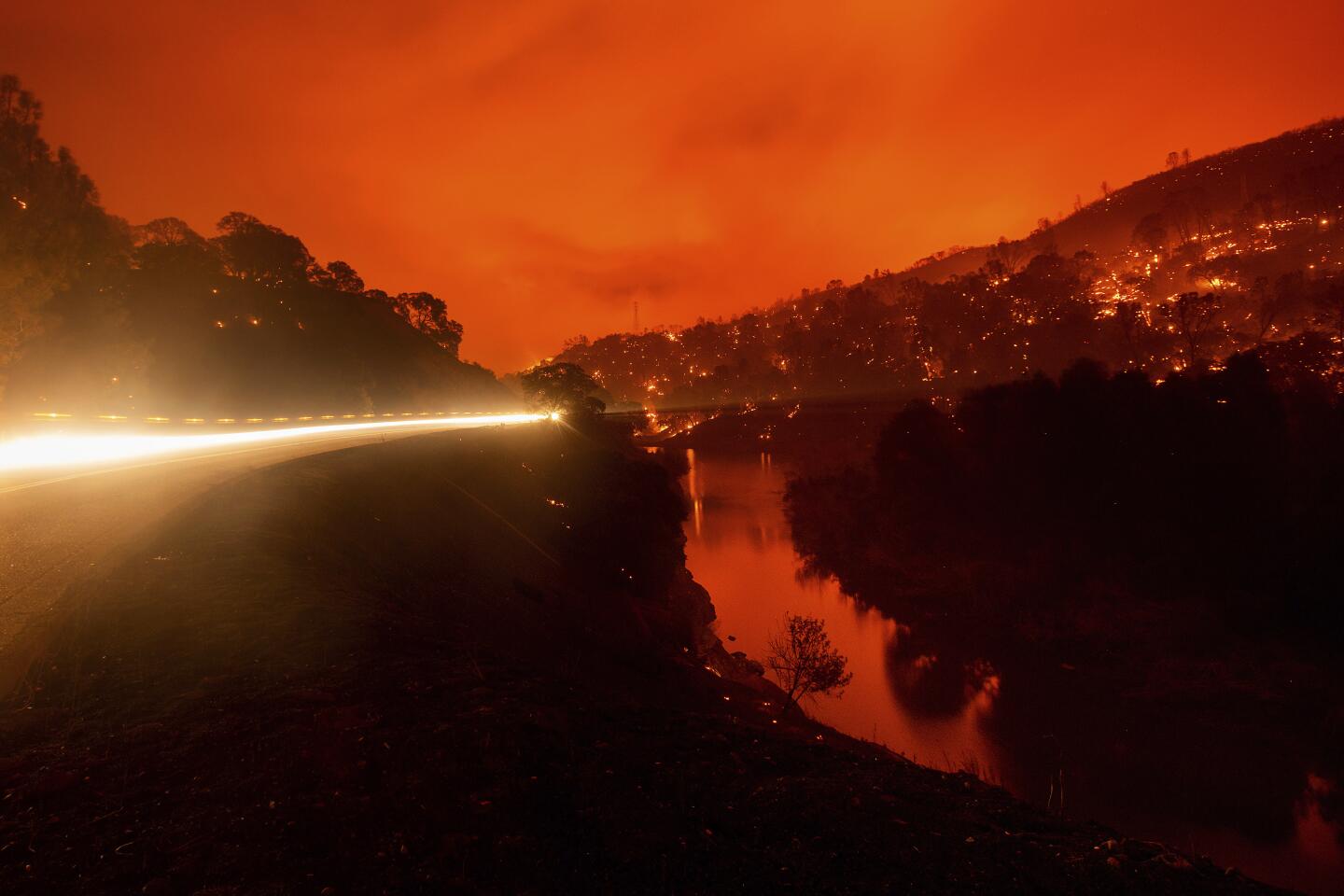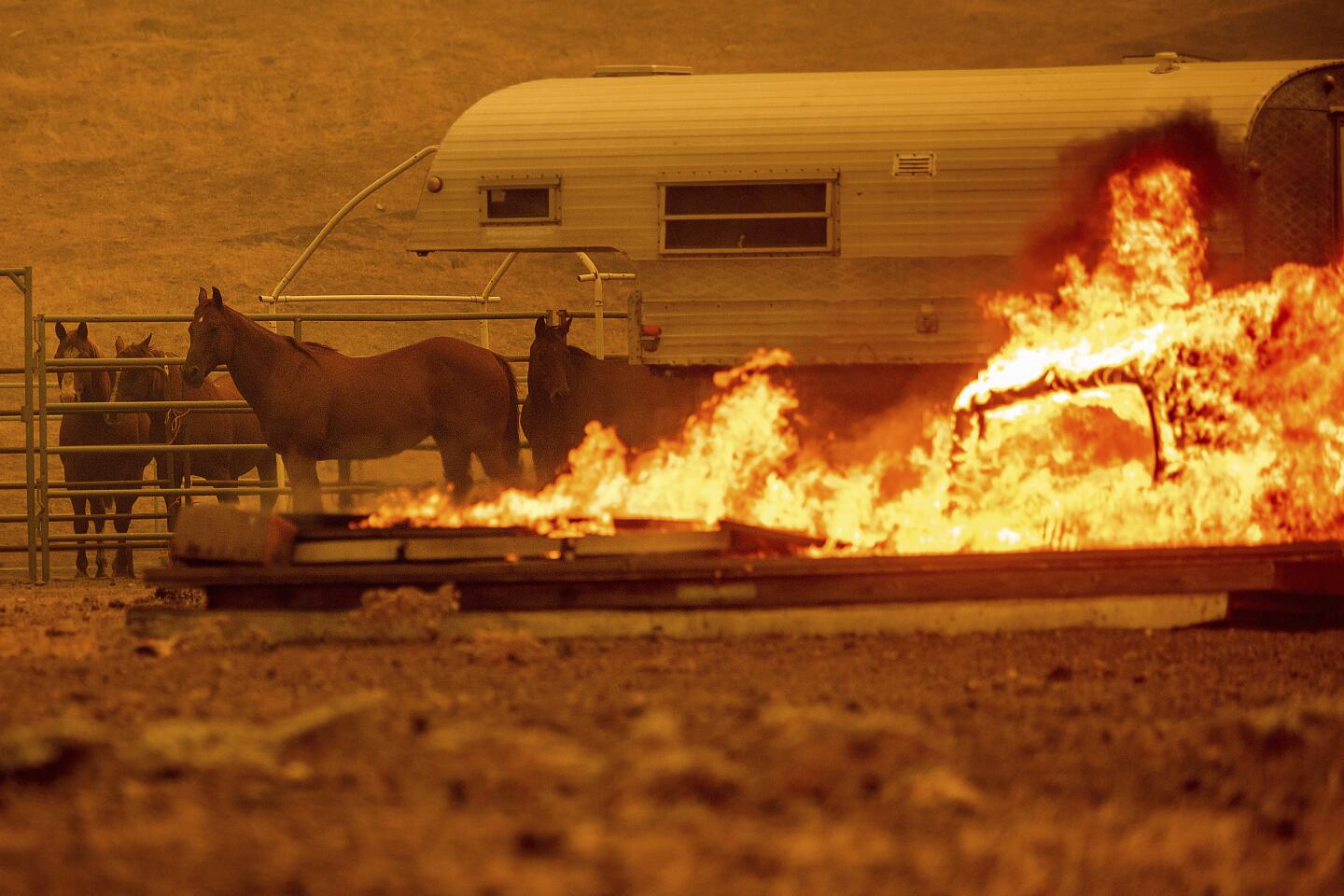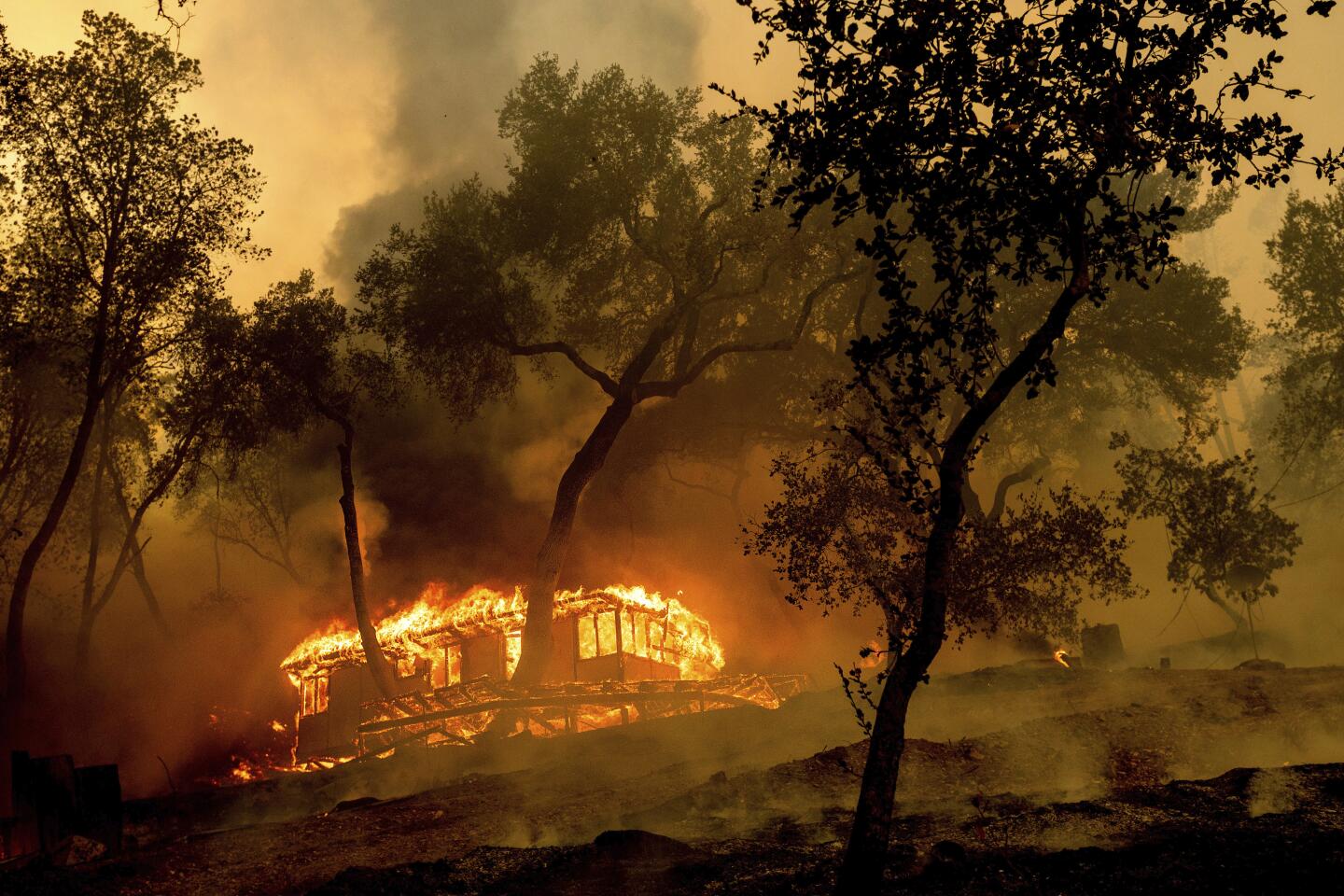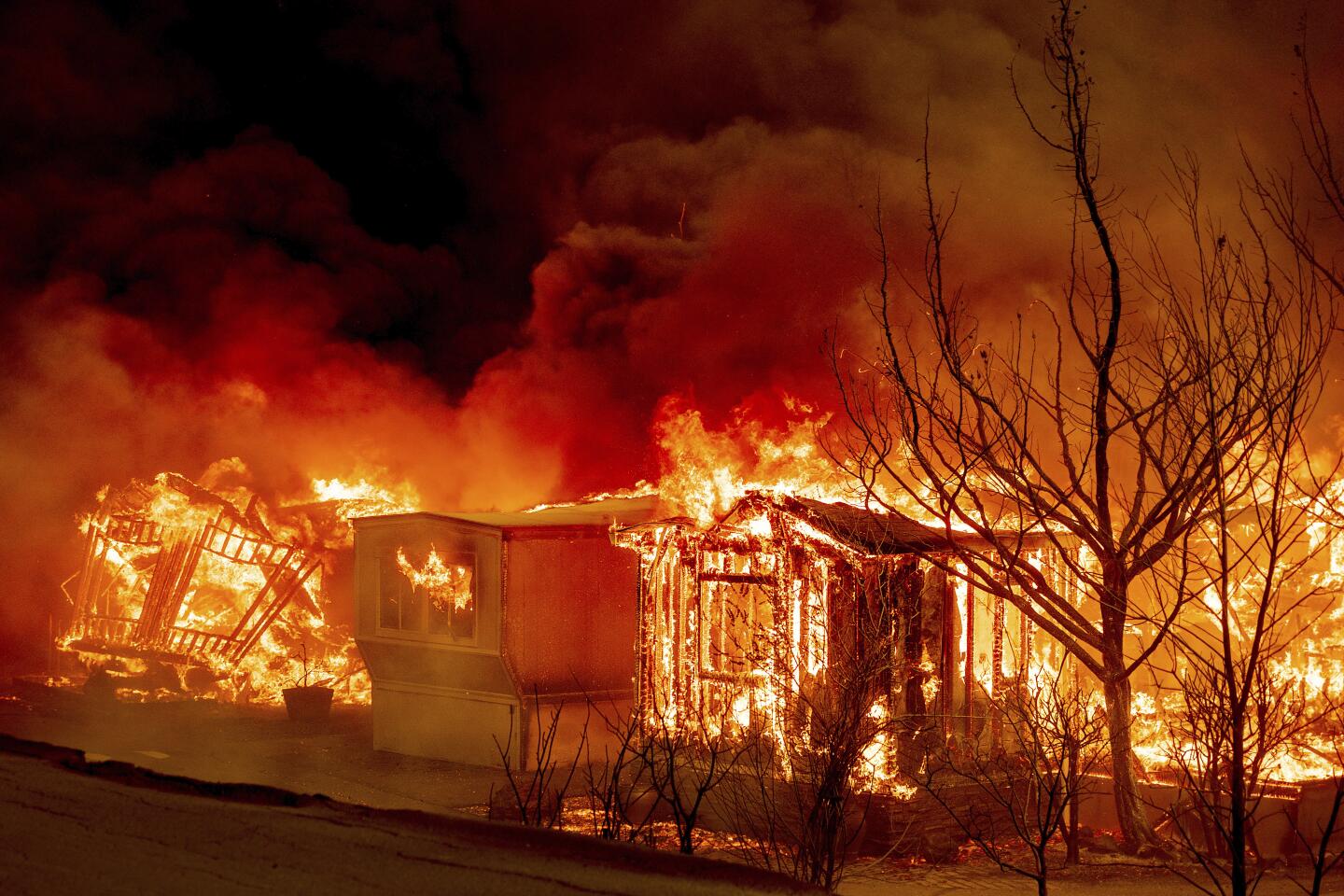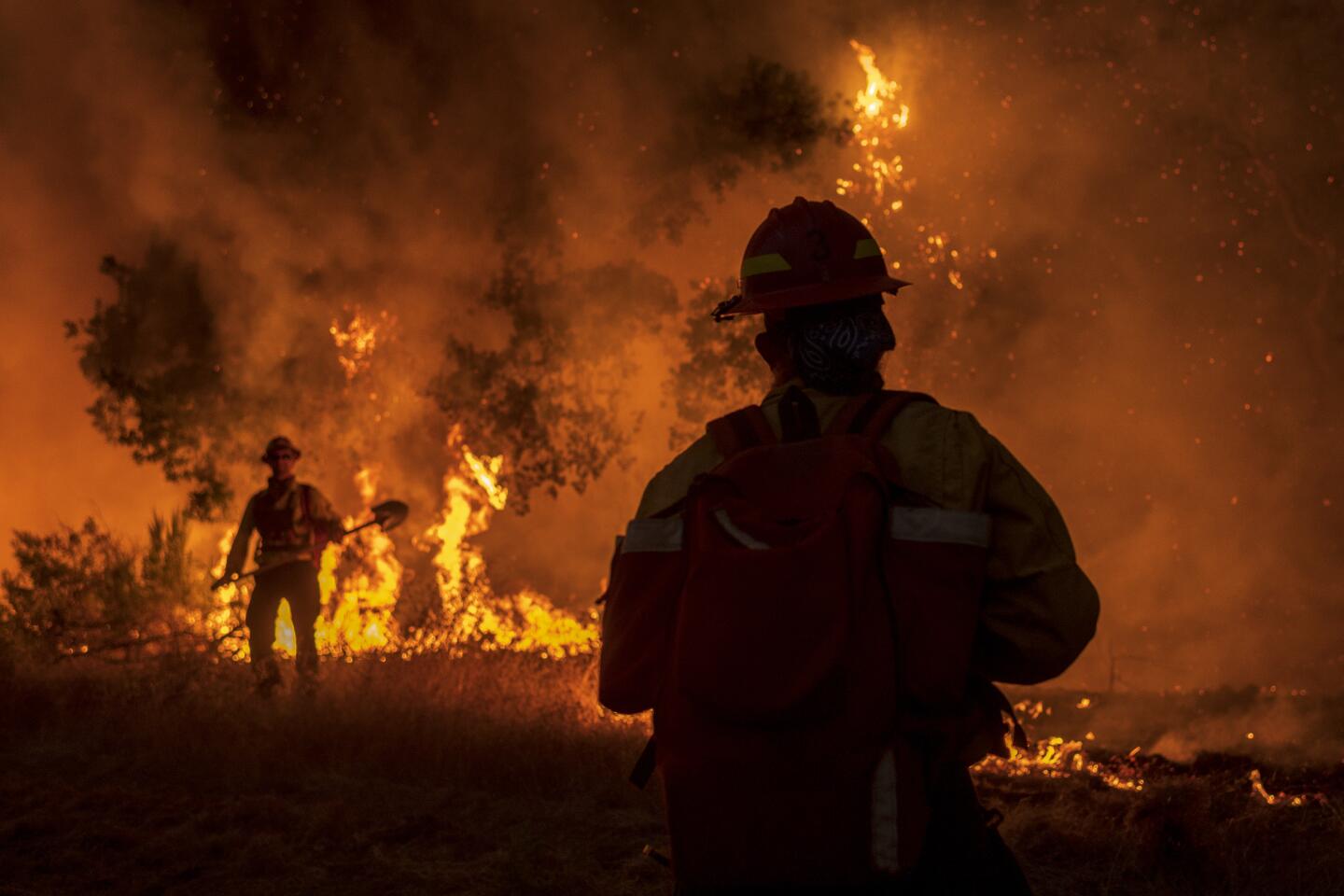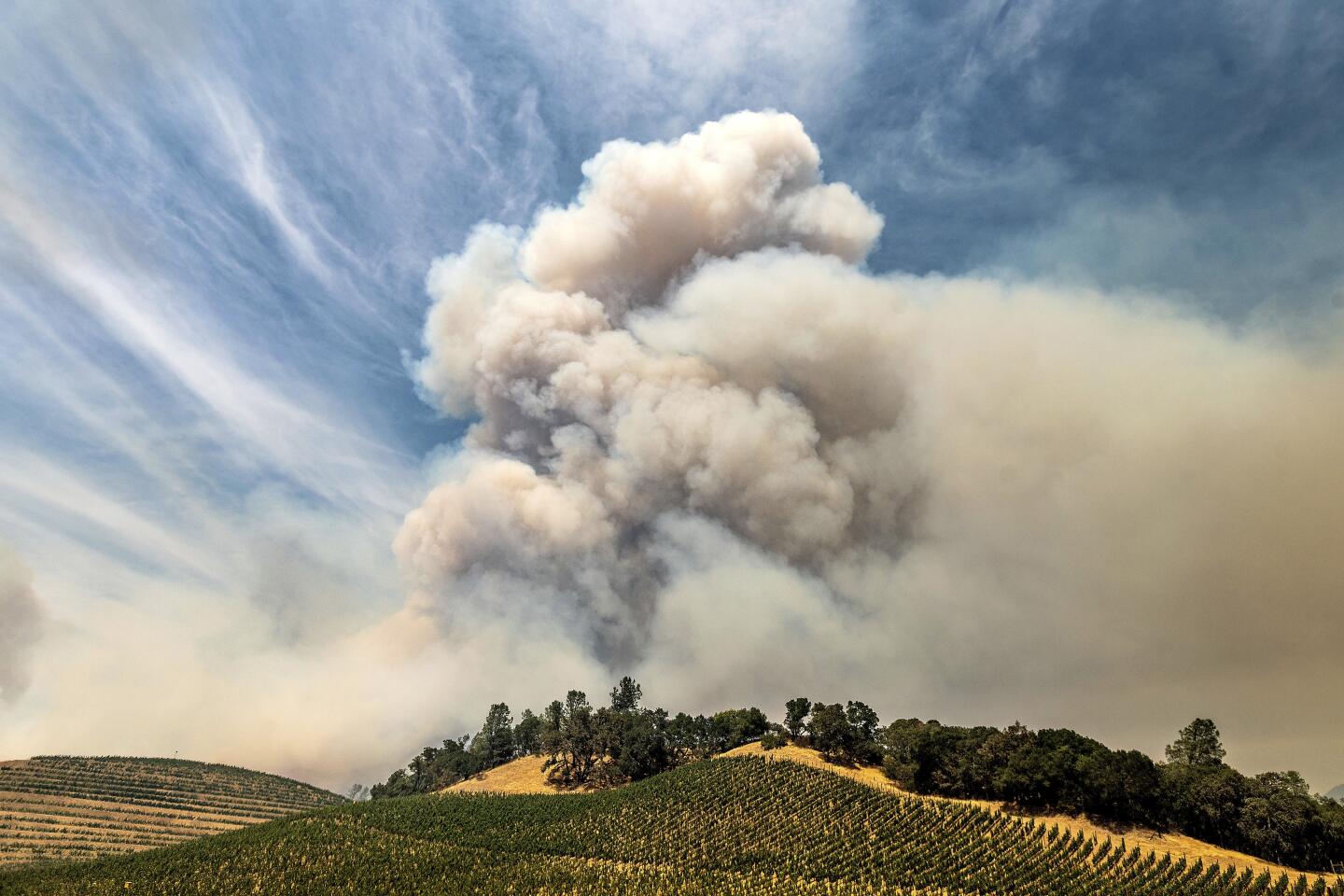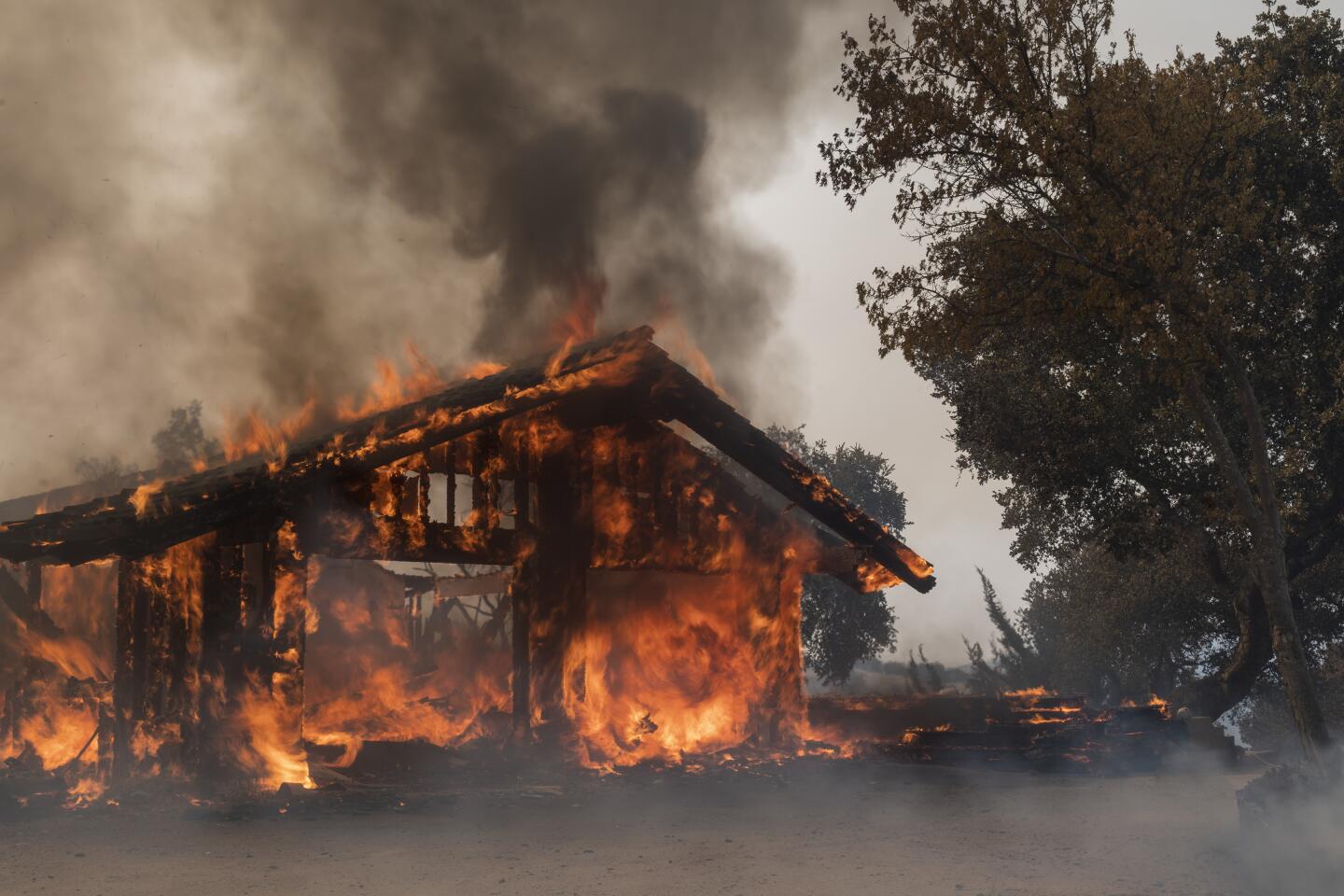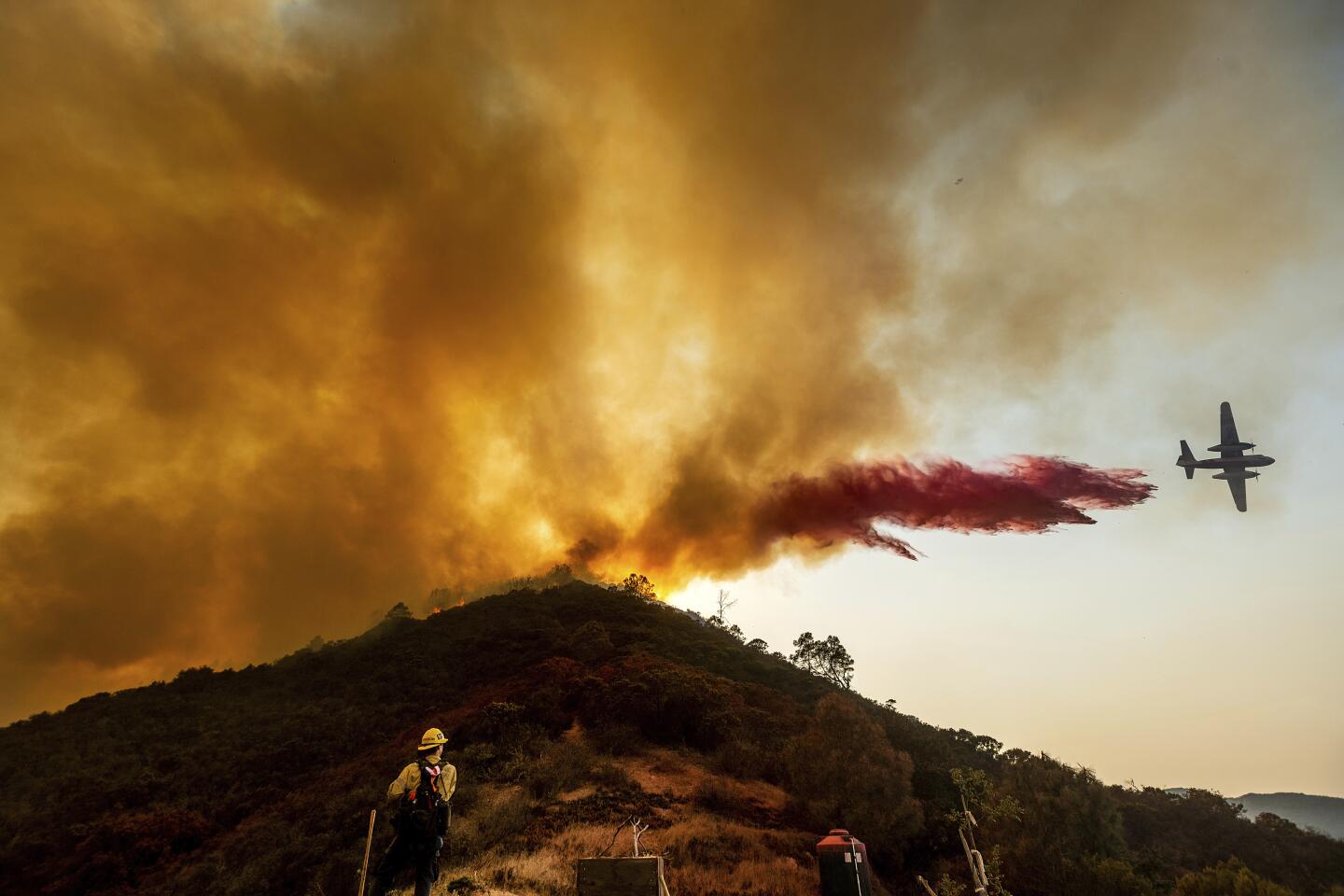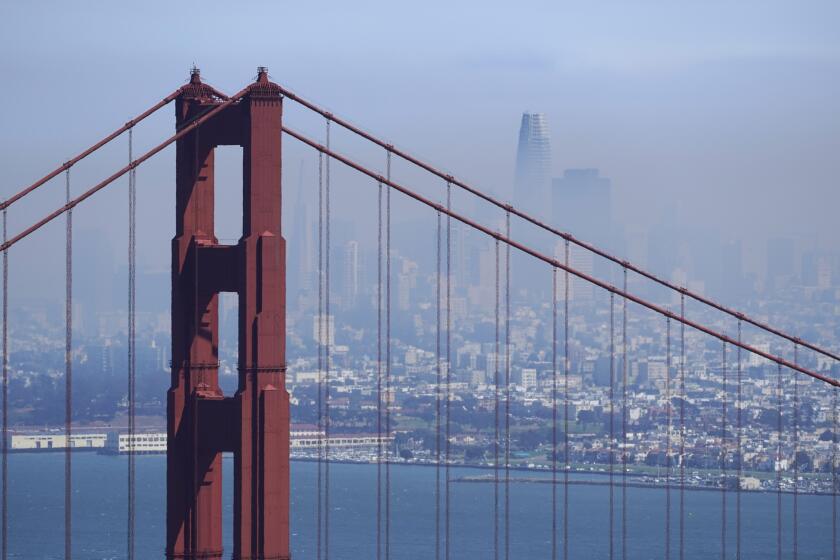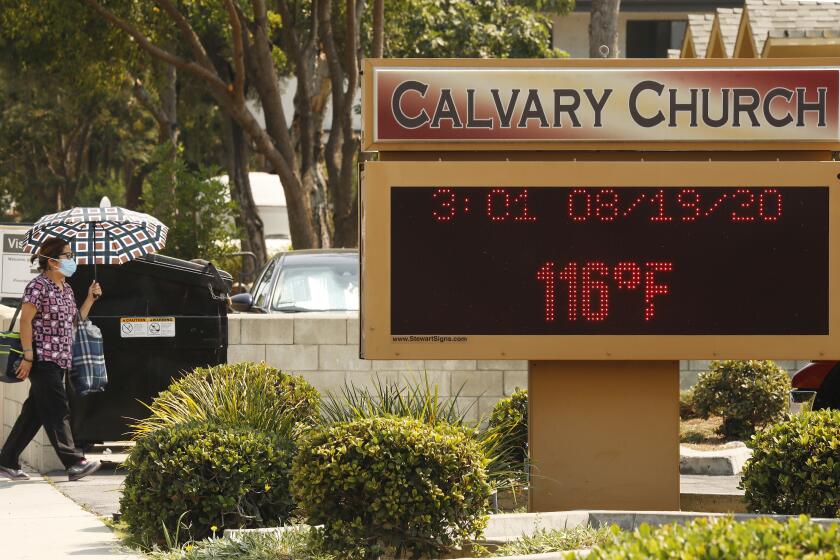Bay Area fires rank in the top 5 in California history
- Share via
SANTA CRUZ — A series of wildfires burning an area larger than the state of Rhode Island have depleted California’s firefighting resources and triggered requests for help from across the West, the East Coast and even as far as Australia.
Since Saturday, more than 918,000 acres of California’s forests and shrub lands have burned, many of them sparked by a weekend lightning storm stretching hundreds of miles and stoked by one of the worst heat waves in recent memory.
The blazes include the LNU Lightning Complex fire, which at more than 302,000 acres is the second-largest fire in California history. The SCU Lightning Complex fire, currently covering more than 274,000 acres, is fourth largest.
“These fires again are stretching our resources, our personnel,” Gov. Gavin Newsom said during a Friday media briefing.
About 96% of the fire engines with the California Department of Forestry and Fire Protection are already committed to wildfires, with little in the way of local assistance. Oregon, Arizona and Washington have all sent firefighters and equipment to help, and there’s a pending request with Australia for their fire crews, Newsom said.
But not all requests from California for out-of-state resources are being granted. Officials with the National Interagency Fire Center in Idaho, which coordinates interstate firefighting deployments, said they’ve been inundated with requests from across the West and have redirected some of California’s requests back home.
“It’s difficult with what’s happening across Northern California right now,” said Sean Kavanaugh, Cal Fire’s incident commander on the LNU Lightning Complex fire, which is burning in Napa, Sonoma, Lake, Yolo and Solano counties.
While the fires could not be predicted, the strain on firefighting resources was.
Cal Fire’s union leadership began sounding the alarm about a depletion of resources in the spring, when the COVID outbreak triggered early releases from prisons and with that, a loss of hundreds of inmate firefighters who annually help set up defensive lines around wildfires. Inmate firefighters make up about 43% of Cal Fire’s firefighting force.
Since the outbreak began, the California Department of Corrections and Rehabilitation has released more than 800 inmate firefighters, with about 600 of those releases coming since July.
“A combination of expedited and natural releases have contributed to the recent decrease in the conservation camp population,” CDCR spokesman Aaron Francis said in an email.
The state is down to 1,659 inmate firefighters from the 2,255 available in April.
Overall, 1,300 inmates are deployed across the state assisting with some of the most grueling work in firefighting: marching into rugged terrain with hand tools to cut away brush and scrape the earth free of anything that could burn.
The state hired some 800 seasonal workers “just in time” to offset the loss in inmates at the cost of about $72 million, Newsom said.
“We have more people, but it’s just not enough. We have more air support, and it’s still not enough,” the governor said.
A cluster of wildfires has again prompted evacuations in Sonoma County and other parts of the North Bay.
The fires in Northern and Central California have killed at least five people, destroyed 629 structures and scorched over 1,400 square miles, more than twice the area of the city of Los Angeles and more than three times what burned in the entire state last year. A Pacific Gas & Electric worker also died at the time of the fires, but Cal Fire officials say it was unrelated to the blaze.
“We can confirm that a Vacaville-based troubleman passed away while assisting first responders as they dealt with the LNU Complex Fire,” PG&E said in a statement. “Out of respect for the family’s privacy, we won’t be sharing additional details at this time.”
More than 60,000 people were under evacuation orders Friday in Santa Cruz and San Mateo counties for the CZU Lightning Complex fire, as firefighters hoped to use a break in the extreme heat to make progress.
Mark Brunton, a Cal Fire operations section chief, said at an evening press conference that the fire weather had improved Friday in San Mateo and Santa Cruz counties with cooler temperatures; firefighters did not observe erratic fire behavior. The areas of most concern are communities along the Highway 9 corridor north of Santa Cruz, which have the largest number of buildings in the direct line of fire.
Billy See, a Cal Fire incident commander, said nearly 100 more firefighters showed over the last day, bringing their force to about 1,000 people. The fire has burned at least 57,000 acres.
“It’s still not enough,” he said. “We’re going to continue to bring additional personnel and resources in here.”
Resources are coming in from other states, but it takes a matter of days for that manpower to arrive.
“They’re stretched very, very thin,” See said.
See has said this fire is historic — so much that he’s tired of saying it.
“I’m tired of saying that I’ve never seen something like this in 34 years of fighting fire,” he said. “It’s a dangerous situation.”
The fire has burned through the mountainous Santa Cruz County communities of Boulder Creek and Ben Lomond, destroying a number of structures overnight.
One problem was residents who were refusing to evacuate, forcing firefighters to rescue them.
“When people that do stay behind … try to take matters in their own hands with trying to suppress fires, it creates a bigger issue,” Brunton said. “We had, last night, three separate rescues that pulled our vital — very few resources — away to have to rescue those individuals, because they put themselves in peril. They’re not trained firefighters.”
He added: “In the long run it’s created a bigger problem for first responders, because of that it took our firefighters away from the firefight to rescue them.”
Firefighters must choose which buildings to save.
“We can’t save everything,” Brunton said. “We have to pick and choose our targets of opportunity the best we can.” Properties that have a cleared layer of defensible space — no flammable vegetation in a zone around property — give firefighters the best opportunity to save a home, he said.
The intense smoke caused by the fire, which is burning through timber, has limited the use of firefighting aircraft. The smoke is so bad that the visibility would be akin to flying through fog or dense clouds, and it would be unsafe to have aircraft fly, Brunton said.
The evacuation zone for the fire stretches in the mountains from San Gregorio State Beach, south of Half Moon Bay, to the edge of the city limits of Santa Cruz. The orders reached the UC Santa Cruz campus late Thursday.
San Francisco Bay Area air quality is hazardous. Much of the ground is covered in ash distributed by gusty winds, adding to pollution already clouding the vicinity.
Brant Robertson, a UC Santa Cruz astrophysicist, lives 100 yards from the evacuation zone on the university’s campus.
He said that he had not received a warning but that he and his family — his wife, 11-year-old triplets and dog — were all packed and ready to evacuate at a moment’s notice.
He lives in a cul-de-sac at the edge of campus and said roughly half his neighbors had already left.
Standing on his porch, Robertson said the air was thick with dust and ash, as well as larger particles — burnt leaves and fibers suspended in the wind.
“We have all the windows shut,” he said. “But you can still taste the smoke. It’s unavoidable.”
He and his wife have been constantly following Twitter and keeping an eye on NASA’s satellite imagery.
“I’ve lived all over the place,” Robertson said. “I’ve been through tornadoes and earthquakes. But this is different. You just react to those events. This is unusual in that we don’t know when the alarm is going to go off. But there’s a lot of tension. It’s continuously stressful to hurry up and wait.”
He said the schools have closed for at least the next week as families and teachers evacuate. Even though classes were being taught remotely, the evacuations have made teaching and learning impossible.
He said this last week has been exhausting, starting with the heat wave. His phone recorded a high of 108 degrees at his house one day.
Then there were the blackouts, as the electrical grid was overwhelmed amid the heat.
He said that the supercomputers he uses as a physicist were intermittently shutting on and off. He lost a ton of data.
“Then the storms hit,” he said of the lightning storms that moved across the region Sunday and Monday. “It cooled off, but then the smoke began to build” as a result of the fires.
And now his family is on the edge of evacuation.
The California Independent System Operator, which runs the electric grid for most of the state, said further power outages aren’t anticipated.
With more than 18,000 students enrolled at UC Santa Cruz, the university is working to find hotel or other rooms for students, although it’s unclear how many were on campus or in the community when the evacuations were announced.
The fire also seriously damaged Big Basin Redwoods State Park, northwest of Santa Cruz, prompting a conservation group on Thursday to openly mourn the loss of California’s oldest state park.
“We are devastated to report that Big Basin, as we have known it, loved it, and cherished it for generations, is gone,” said the Sempervirens Fund in a statement. “Early reports are that the wildfire has consumed much of the park’s historic facilities. We do not yet know the fate of the park’s grandest old trees.”
Farther inland, in the mountains east of San Jose, the SCU Lightning Complex fire has grown to more than 274,000 acres, making it the fourth largest fire in recorded state history. It has destroyed five buildings.
So many fires burned in the numerous low mountain ranges surrounding the San Francisco Bay that the region was home to the world’s worst air quality earlier in the week, according to the website PurpleAir.
One major cluster of blazes is in wine country. The LNU Lightning Complex fire has blackened more than 302,000 acres, destroyed 480 structures and triggered the evacuation of nonessential personnel from Travis Air Force Base in Solano County and patients from Adventist Health St. Helena hospital in Napa County. It was 15% contained Friday evening as the area had cooled overnight.
The largest in the complex is the Hennessey fire, which is so big at more than 256,000 acres that on Friday it had nearly surrounded Lake Berryessa, one of California’s largest reservoirs. It has merged with a number of other fires.
The activity of the Hennessey fire on its southern edge — including in the direction of Vacaville and Fairfield in Solano County — has dropped off significantly, said Chris Waters, a Cal Fire operations section chief, on Friday. Travis Air Force Base in Fairfield has canceled its evacuations for nonessential personnel; evacuations for parts of Vacaville were also canceled.
The Hennessey fire, however, is still active on its northern edge, and threatening Pope Valley in Napa County. It has neared the Yocha Dehe Wintun Nation tribal community in Yolo County, which operates Cache Creek Casino Resort.
The second fire, the 43,286-acre Walbridge fire, in northern Sonoma County, was moving Friday toward the town of Guerneville on the Russian River.
“Right now we have engines, dozers, hand crews and law enforcement working in the Walbridge fire right now to try and slow the spread of the fire down,” Waters said. “We’re also organizing evacuations and warnings for the community of Guerneville.”
The third fire, the Myers fire on the Sonoma County coast, has stopped moving and should be contained fairly soon, Waters said.
“These fires are burning in areas that have not burned in decades. The fuel load is extremely high. The conditions are very dry. And the winds will continue to pick up throughout the day,” Assemblyman Jim Wood (D-Santa Rosa) said of the fires burning in Sonoma County.
By Friday afternoon, there were more than 1,000 people fighting the LNU Lightning Complex fire in the North Bay, significantly above the 587 people working the fire on Thursday.
Looking ahead, there is a chance that another string of lightning storms could hit the coastal mountains over the weekend, San Jose State atmospheric scientist Alison Bridger said.
The dome of heat that crawled up from Arizona last week and baked Northern California is going to reestablish itself, although temperatures won’t reach the same extremes, she said.
At the same time, another storm off the Mexican coast is poised to feed that heat dome moisture, which would destabilize it, laying the groundwork for thunderstorms.
“And then all you need is a little energy to spark it and you’ll get more lightning and thunder,” Bridger said.
The storms would develop fairly rapidly, so it won’t be clear whether there will be lightning and where it would strike until possibly Sunday morning, she added.
The National Weather Service has issued a wide ranging fire weather watch for large swaths of Northern and Central California beginning Sunday morning through Tuesday, saying “fast moving … thunderstorms may lead to a risk of dry lightning and new fire starts.”
Residents Friday morning in the mountain town of Inskip in Butte County were told to pack up and leave ahead of the approaching fires. And in Monterey County, officials have issued an evacuation warning for the Carmel Valley — known for its rolling hills, vineyards and hotels — and the adjacent Laureles Grade area, which is close to the River and Carmel fires that have already destroyed at least 38 structures. Monterey County supervisor Mary Adams urged people to act early “so that we don’t have a glut of traffic on Carmel Valley Road should the order to evacuate comes.”
Meanwhile, families evacuated from their homes for more than a week in Riverside County were told they can begin to return as crews gathered momentum against the Apple fire, the first big wildfire of the season.
For all the sweltering humidity Southern Californians have been experiencing lately, it’s been extremely dry up north, experts say.
“The fire concentration, the challenge we’re facing in the state is now disproportionately affecting California,” the governor said. Crews that were battling the Apple fire are now headed north. And when they get there, they’ll be fighting fires on myriad fronts.
Rust reported from Santa Cruz, Lin from San Francisco and Serna from Los Angeles. Times staff writers Anita Chabria in Healdsburg and Stuart Leavenworth, Luke Money and Leila Miller in Los Angeles contributed to this report.
More to Read
Sign up for Essential California
The most important California stories and recommendations in your inbox every morning.
You may occasionally receive promotional content from the Los Angeles Times.
